Assignment on Information Technology PDF
VerifiedAdded on 2021/01/03
|32
|6903
|144
AI Summary
Contribute Materials
Your contribution can guide someone’s learning journey. Share your
documents today.
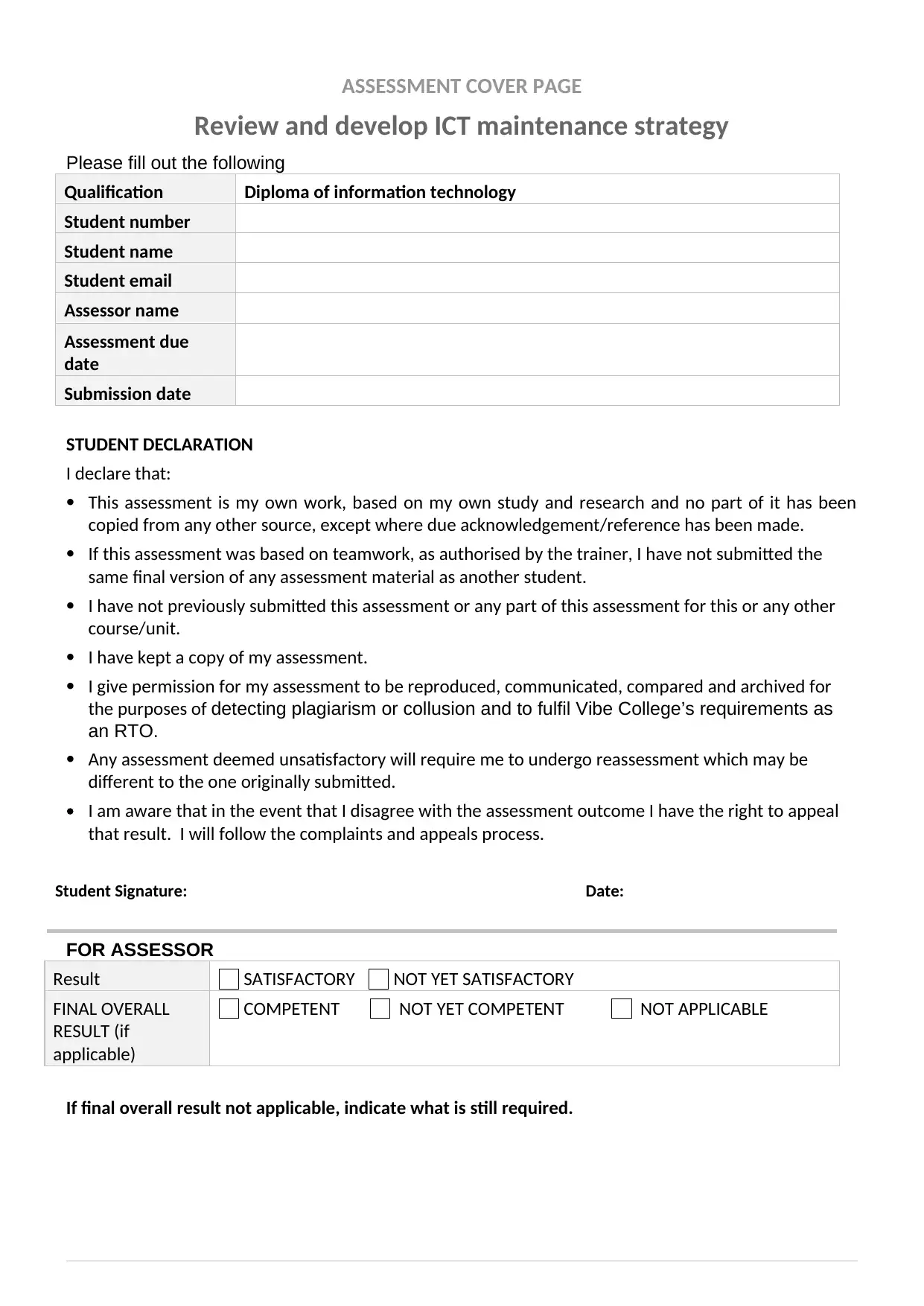
ASSESSMENT COVER PAGE
Review and develop ICT maintenance strategy
Please fill out the following
Qualification Diploma of information technology
Student number
Student name
Student email
Assessor name
Assessment due
date
Submission date
STUDENT DECLARATION
I declare that:
This assessment is my own work, based on my own study and research and no part of it has been
copied from any other source, except where due acknowledgement/reference has been made.
If this assessment was based on teamwork, as authorised by the trainer, I have not submitted the
same final version of any assessment material as another student.
I have not previously submitted this assessment or any part of this assessment for this or any other
course/unit.
I have kept a copy of my assessment.
I give permission for my assessment to be reproduced, communicated, compared and archived for
the purposes of detecting plagiarism or collusion and to fulfil Vibe College’s requirements as
an RTO.
Any assessment deemed unsatisfactory will require me to undergo reassessment which may be
different to the one originally submitted.
I am aware that in the event that I disagree with the assessment outcome I have the right to appeal
that result. I will follow the complaints and appeals process.
Student Signature: Date:
FOR ASSESSOR
Result SATISFACTORY NOT YET SATISFACTORY
FINAL OVERALL
RESULT (if
applicable)
COMPETENT NOT YET COMPETENT NOT APPLICABLE
If final overall result not applicable, indicate what is still required.
Review and develop ICT maintenance strategy
Please fill out the following
Qualification Diploma of information technology
Student number
Student name
Student email
Assessor name
Assessment due
date
Submission date
STUDENT DECLARATION
I declare that:
This assessment is my own work, based on my own study and research and no part of it has been
copied from any other source, except where due acknowledgement/reference has been made.
If this assessment was based on teamwork, as authorised by the trainer, I have not submitted the
same final version of any assessment material as another student.
I have not previously submitted this assessment or any part of this assessment for this or any other
course/unit.
I have kept a copy of my assessment.
I give permission for my assessment to be reproduced, communicated, compared and archived for
the purposes of detecting plagiarism or collusion and to fulfil Vibe College’s requirements as
an RTO.
Any assessment deemed unsatisfactory will require me to undergo reassessment which may be
different to the one originally submitted.
I am aware that in the event that I disagree with the assessment outcome I have the right to appeal
that result. I will follow the complaints and appeals process.
Student Signature: Date:
FOR ASSESSOR
Result SATISFACTORY NOT YET SATISFACTORY
FINAL OVERALL
RESULT (if
applicable)
COMPETENT NOT YET COMPETENT NOT APPLICABLE
If final overall result not applicable, indicate what is still required.
Secure Best Marks with AI Grader
Need help grading? Try our AI Grader for instant feedback on your assignments.
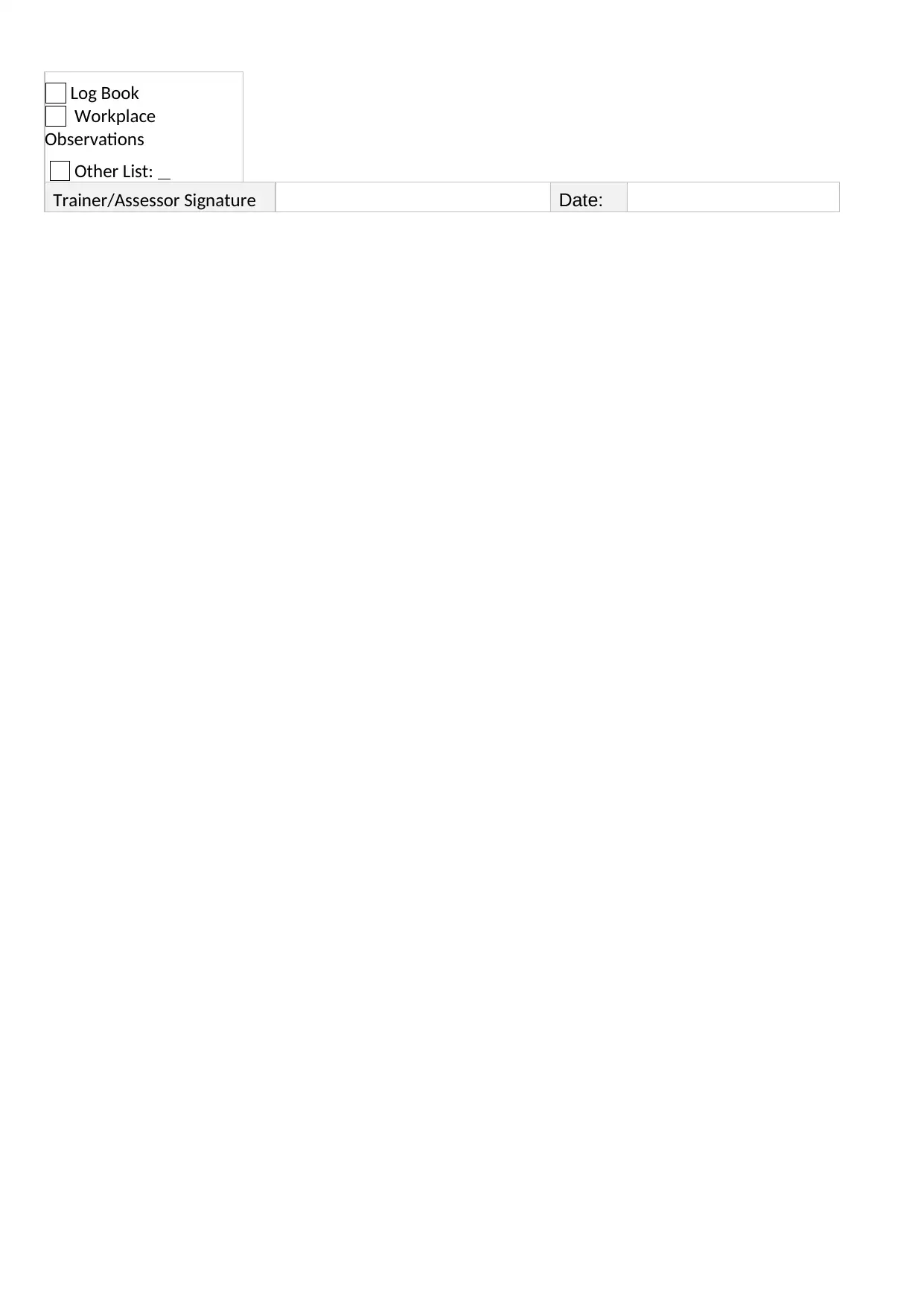
Log Book
Workplace
Observations
Other List:
Trainer/Assessor Signature Date:
Workplace
Observations
Other List:
Trainer/Assessor Signature Date:
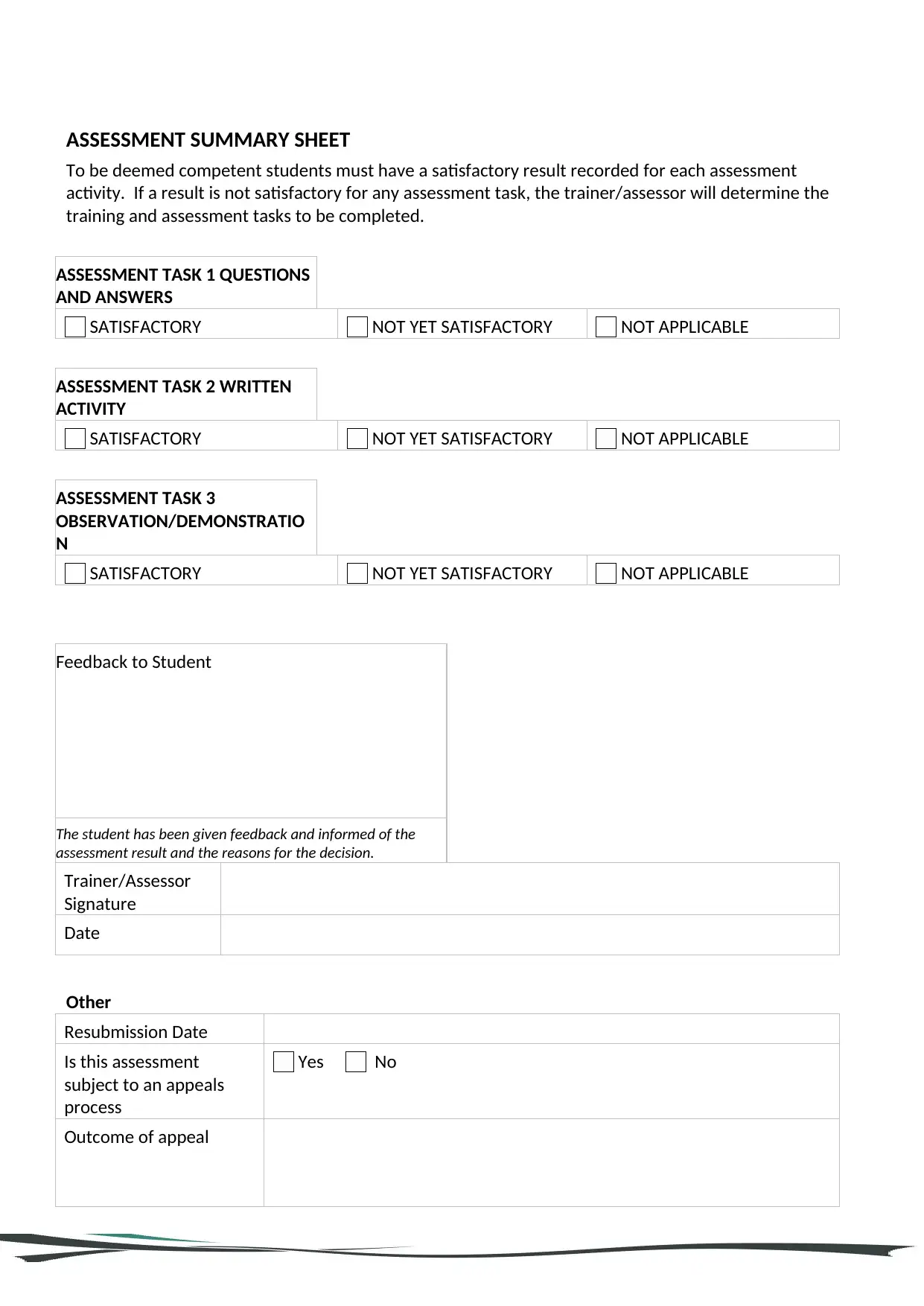
ASSESSMENT SUMMARY SHEET
To be deemed competent students must have a satisfactory result recorded for each assessment
activity. If a result is not satisfactory for any assessment task, the trainer/assessor will determine the
training and assessment tasks to be completed.
ASSESSMENT TASK 1 QUESTIONS
AND ANSWERS
SATISFACTORY NOT YET SATISFACTORY NOT APPLICABLE
ASSESSMENT TASK 2 WRITTEN
ACTIVITY
SATISFACTORY NOT YET SATISFACTORY NOT APPLICABLE
ASSESSMENT TASK 3
OBSERVATION/DEMONSTRATIO
N
SATISFACTORY NOT YET SATISFACTORY NOT APPLICABLE
Feedback to Student
The student has been given feedback and informed of the
assessment result and the reasons for the decision.
Trainer/Assessor
Signature
Date
Other
Resubmission Date
Is this assessment
subject to an appeals
process
Yes No
Outcome of appeal
To be deemed competent students must have a satisfactory result recorded for each assessment
activity. If a result is not satisfactory for any assessment task, the trainer/assessor will determine the
training and assessment tasks to be completed.
ASSESSMENT TASK 1 QUESTIONS
AND ANSWERS
SATISFACTORY NOT YET SATISFACTORY NOT APPLICABLE
ASSESSMENT TASK 2 WRITTEN
ACTIVITY
SATISFACTORY NOT YET SATISFACTORY NOT APPLICABLE
ASSESSMENT TASK 3
OBSERVATION/DEMONSTRATIO
N
SATISFACTORY NOT YET SATISFACTORY NOT APPLICABLE
Feedback to Student
The student has been given feedback and informed of the
assessment result and the reasons for the decision.
Trainer/Assessor
Signature
Date
Other
Resubmission Date
Is this assessment
subject to an appeals
process
Yes No
Outcome of appeal

Secure Best Marks with AI Grader
Need help grading? Try our AI Grader for instant feedback on your assignments.
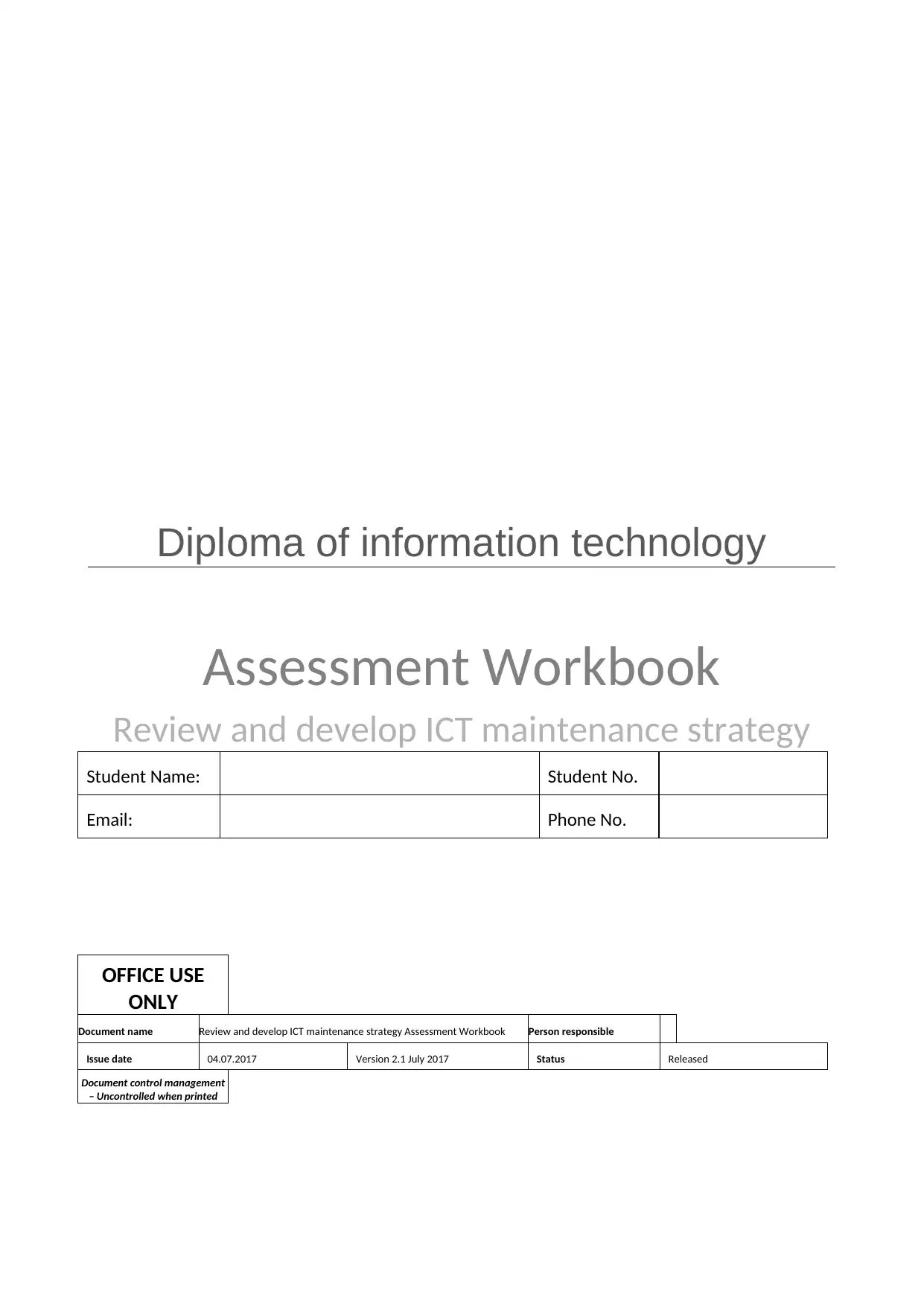
Diploma of information technology
Assessment Workbook
Review and develop ICT maintenance strategy
Student Name: Student No.
Email: Phone No.
OFFICE USE
ONLY
Document name Review and develop ICT maintenance strategy Assessment Workbook Person responsible
Issue date 04.07.2017 Version 2.1 July 2017 Status Released
Document control management
– Uncontrolled when printed
Assessment Workbook
Review and develop ICT maintenance strategy
Student Name: Student No.
Email: Phone No.
OFFICE USE
ONLY
Document name Review and develop ICT maintenance strategy Assessment Workbook Person responsible
Issue date 04.07.2017 Version 2.1 July 2017 Status Released
Document control management
– Uncontrolled when printed
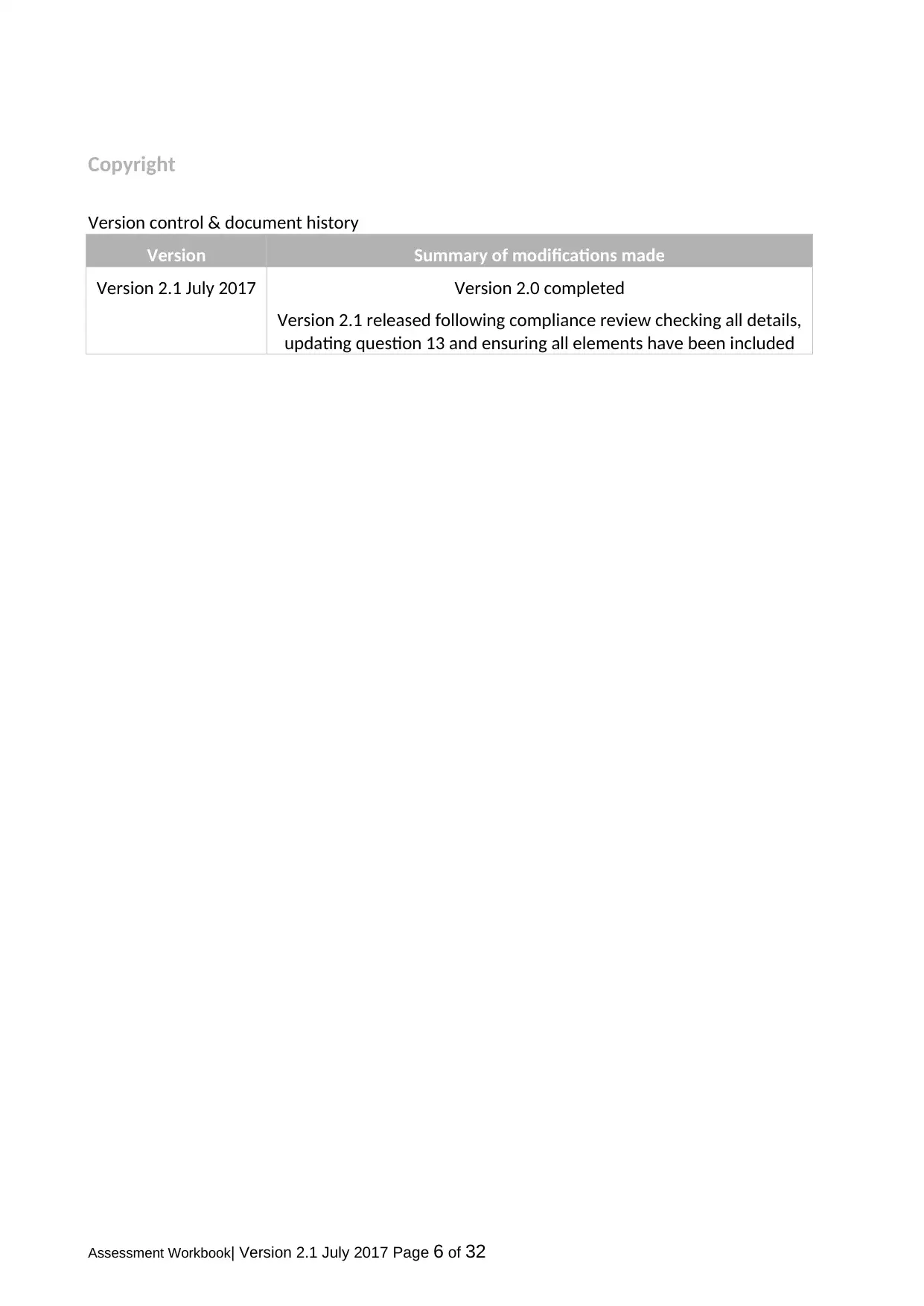
Copyright
Version control & document history
Version Summary of modifications made
Version 2.1 July 2017 Version 2.0 completed
Version 2.1 released following compliance review checking all details,
updating question 13 and ensuring all elements have been included
Assessment Workbook| Version 2.1 July 2017 Page 6 of 32
Version control & document history
Version Summary of modifications made
Version 2.1 July 2017 Version 2.0 completed
Version 2.1 released following compliance review checking all details,
updating question 13 and ensuring all elements have been included
Assessment Workbook| Version 2.1 July 2017 Page 6 of 32
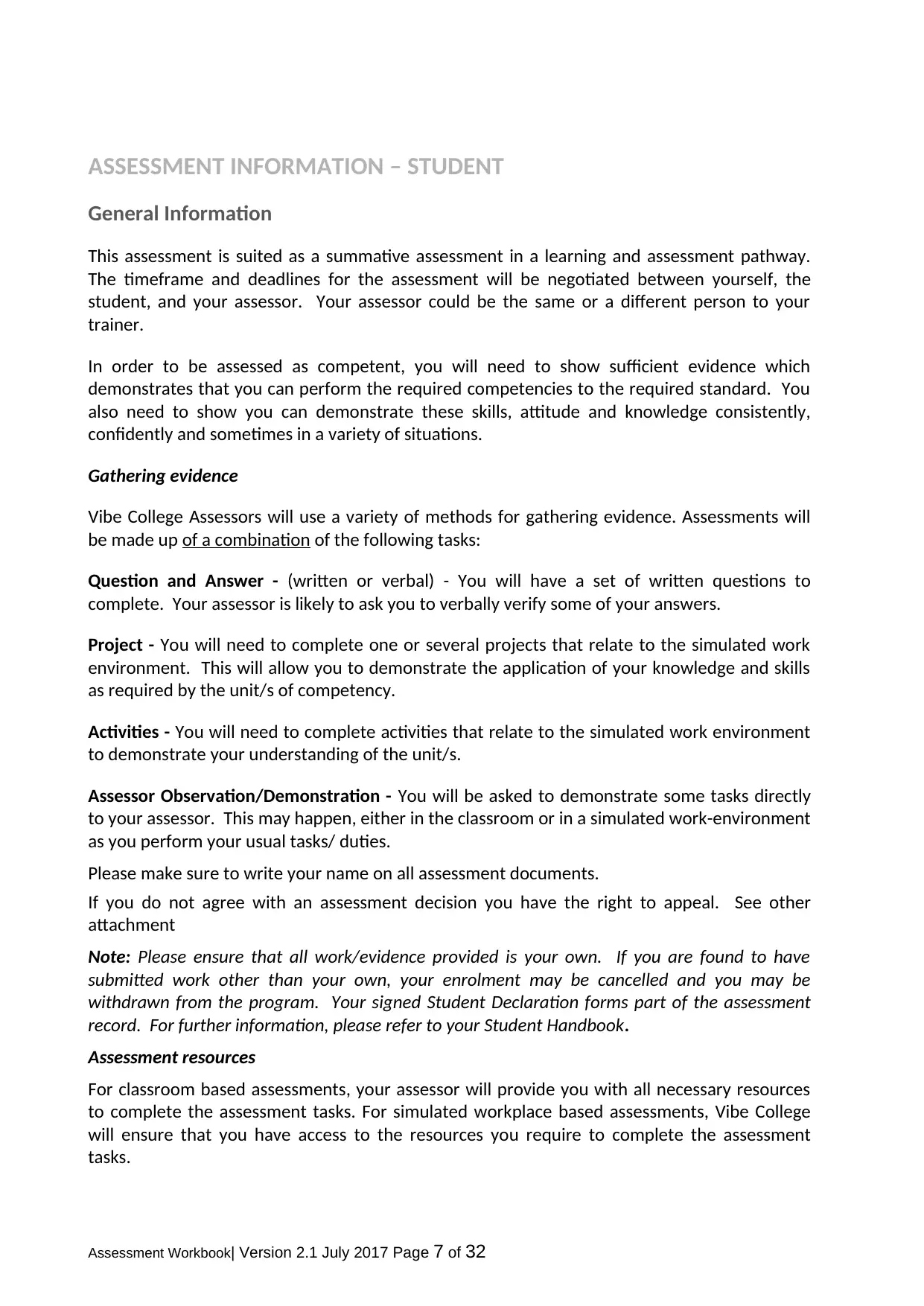
ASSESSMENT INFORMATION – STUDENT
General Information
This assessment is suited as a summative assessment in a learning and assessment pathway.
The timeframe and deadlines for the assessment will be negotiated between yourself, the
student, and your assessor. Your assessor could be the same or a different person to your
trainer.
In order to be assessed as competent, you will need to show sufficient evidence which
demonstrates that you can perform the required competencies to the required standard. You
also need to show you can demonstrate these skills, attitude and knowledge consistently,
confidently and sometimes in a variety of situations.
Gathering evidence
Vibe College Assessors will use a variety of methods for gathering evidence. Assessments will
be made up of a combination of the following tasks:
Question and Answer - (written or verbal) - You will have a set of written questions to
complete. Your assessor is likely to ask you to verbally verify some of your answers.
Project - You will need to complete one or several projects that relate to the simulated work
environment. This will allow you to demonstrate the application of your knowledge and skills
as required by the unit/s of competency.
Activities - You will need to complete activities that relate to the simulated work environment
to demonstrate your understanding of the unit/s.
Assessor Observation/Demonstration - You will be asked to demonstrate some tasks directly
to your assessor. This may happen, either in the classroom or in a simulated work-environment
as you perform your usual tasks/ duties.
Please make sure to write your name on all assessment documents.
If you do not agree with an assessment decision you have the right to appeal. See other
attachment
Note: Please ensure that all work/evidence provided is your own. If you are found to have
submitted work other than your own, your enrolment may be cancelled and you may be
withdrawn from the program. Your signed Student Declaration forms part of the assessment
record. For further information, please refer to your Student Handbook.
Assessment resources
For classroom based assessments, your assessor will provide you with all necessary resources
to complete the assessment tasks. For simulated workplace based assessments, Vibe College
will ensure that you have access to the resources you require to complete the assessment
tasks.
Assessment Workbook| Version 2.1 July 2017 Page 7 of 32
General Information
This assessment is suited as a summative assessment in a learning and assessment pathway.
The timeframe and deadlines for the assessment will be negotiated between yourself, the
student, and your assessor. Your assessor could be the same or a different person to your
trainer.
In order to be assessed as competent, you will need to show sufficient evidence which
demonstrates that you can perform the required competencies to the required standard. You
also need to show you can demonstrate these skills, attitude and knowledge consistently,
confidently and sometimes in a variety of situations.
Gathering evidence
Vibe College Assessors will use a variety of methods for gathering evidence. Assessments will
be made up of a combination of the following tasks:
Question and Answer - (written or verbal) - You will have a set of written questions to
complete. Your assessor is likely to ask you to verbally verify some of your answers.
Project - You will need to complete one or several projects that relate to the simulated work
environment. This will allow you to demonstrate the application of your knowledge and skills
as required by the unit/s of competency.
Activities - You will need to complete activities that relate to the simulated work environment
to demonstrate your understanding of the unit/s.
Assessor Observation/Demonstration - You will be asked to demonstrate some tasks directly
to your assessor. This may happen, either in the classroom or in a simulated work-environment
as you perform your usual tasks/ duties.
Please make sure to write your name on all assessment documents.
If you do not agree with an assessment decision you have the right to appeal. See other
attachment
Note: Please ensure that all work/evidence provided is your own. If you are found to have
submitted work other than your own, your enrolment may be cancelled and you may be
withdrawn from the program. Your signed Student Declaration forms part of the assessment
record. For further information, please refer to your Student Handbook.
Assessment resources
For classroom based assessments, your assessor will provide you with all necessary resources
to complete the assessment tasks. For simulated workplace based assessments, Vibe College
will ensure that you have access to the resources you require to complete the assessment
tasks.
Assessment Workbook| Version 2.1 July 2017 Page 7 of 32
Paraphrase This Document
Need a fresh take? Get an instant paraphrase of this document with our AI Paraphraser
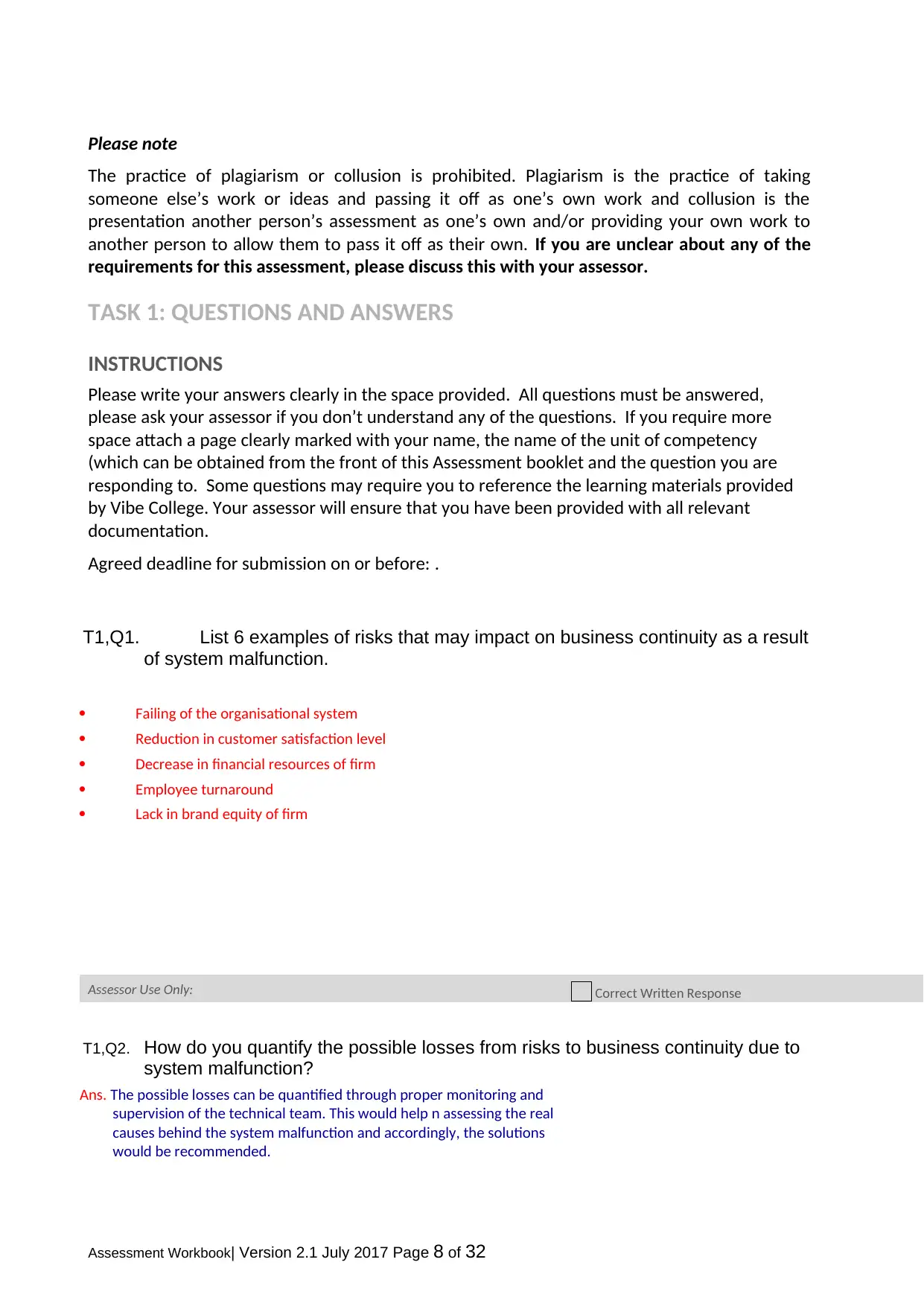
Please note
The practice of plagiarism or collusion is prohibited. Plagiarism is the practice of taking
someone else’s work or ideas and passing it off as one’s own work and collusion is the
presentation another person’s assessment as one’s own and/or providing your own work to
another person to allow them to pass it off as their own. If you are unclear about any of the
requirements for this assessment, please discuss this with your assessor.
TASK 1: QUESTIONS AND ANSWERS
INSTRUCTIONS
Please write your answers clearly in the space provided. All questions must be answered,
please ask your assessor if you don’t understand any of the questions. If you require more
space attach a page clearly marked with your name, the name of the unit of competency
(which can be obtained from the front of this Assessment booklet and the question you are
responding to. Some questions may require you to reference the learning materials provided
by Vibe College. Your assessor will ensure that you have been provided with all relevant
documentation.
Agreed deadline for submission on or before: .
T1,Q1. List 6 examples of risks that may impact on business continuity as a result
of system malfunction.
Failing of the organisational system
Reduction in customer satisfaction level
Decrease in financial resources of firm
Employee turnaround
Lack in brand equity of firm
Assessor Use Only: Correct Written Response
T1,Q2. How do you quantify the possible losses from risks to business continuity due to
system malfunction?
Ans. The possible losses can be quantified through proper monitoring and
supervision of the technical team. This would help n assessing the real
causes behind the system malfunction and accordingly, the solutions
would be recommended.
Assessment Workbook| Version 2.1 July 2017 Page 8 of 32
The practice of plagiarism or collusion is prohibited. Plagiarism is the practice of taking
someone else’s work or ideas and passing it off as one’s own work and collusion is the
presentation another person’s assessment as one’s own and/or providing your own work to
another person to allow them to pass it off as their own. If you are unclear about any of the
requirements for this assessment, please discuss this with your assessor.
TASK 1: QUESTIONS AND ANSWERS
INSTRUCTIONS
Please write your answers clearly in the space provided. All questions must be answered,
please ask your assessor if you don’t understand any of the questions. If you require more
space attach a page clearly marked with your name, the name of the unit of competency
(which can be obtained from the front of this Assessment booklet and the question you are
responding to. Some questions may require you to reference the learning materials provided
by Vibe College. Your assessor will ensure that you have been provided with all relevant
documentation.
Agreed deadline for submission on or before: .
T1,Q1. List 6 examples of risks that may impact on business continuity as a result
of system malfunction.
Failing of the organisational system
Reduction in customer satisfaction level
Decrease in financial resources of firm
Employee turnaround
Lack in brand equity of firm
Assessor Use Only: Correct Written Response
T1,Q2. How do you quantify the possible losses from risks to business continuity due to
system malfunction?
Ans. The possible losses can be quantified through proper monitoring and
supervision of the technical team. This would help n assessing the real
causes behind the system malfunction and accordingly, the solutions
would be recommended.
Assessment Workbook| Version 2.1 July 2017 Page 8 of 32
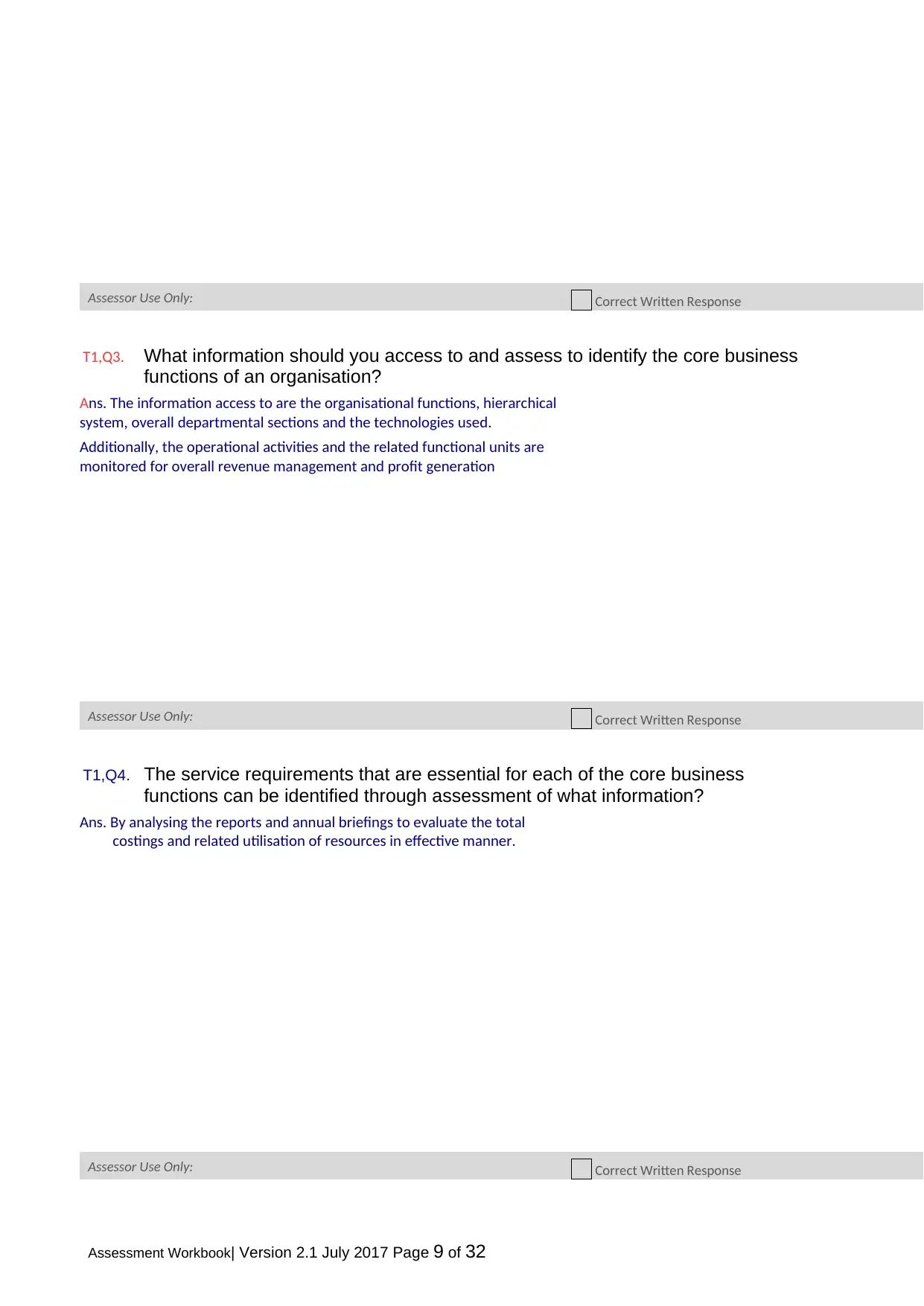
Assessor Use Only: Correct Written Response
T1,Q3. What information should you access to and assess to identify the core business
functions of an organisation?
Ans. The information access to are the organisational functions, hierarchical
system, overall departmental sections and the technologies used.
Additionally, the operational activities and the related functional units are
monitored for overall revenue management and profit generation
Assessor Use Only: Correct Written Response
T1,Q4. The service requirements that are essential for each of the core business
functions can be identified through assessment of what information?
Ans. By analysing the reports and annual briefings to evaluate the total
costings and related utilisation of resources in effective manner.
Assessor Use Only: Correct Written Response
Assessment Workbook| Version 2.1 July 2017 Page 9 of 32
T1,Q3. What information should you access to and assess to identify the core business
functions of an organisation?
Ans. The information access to are the organisational functions, hierarchical
system, overall departmental sections and the technologies used.
Additionally, the operational activities and the related functional units are
monitored for overall revenue management and profit generation
Assessor Use Only: Correct Written Response
T1,Q4. The service requirements that are essential for each of the core business
functions can be identified through assessment of what information?
Ans. By analysing the reports and annual briefings to evaluate the total
costings and related utilisation of resources in effective manner.
Assessor Use Only: Correct Written Response
Assessment Workbook| Version 2.1 July 2017 Page 9 of 32
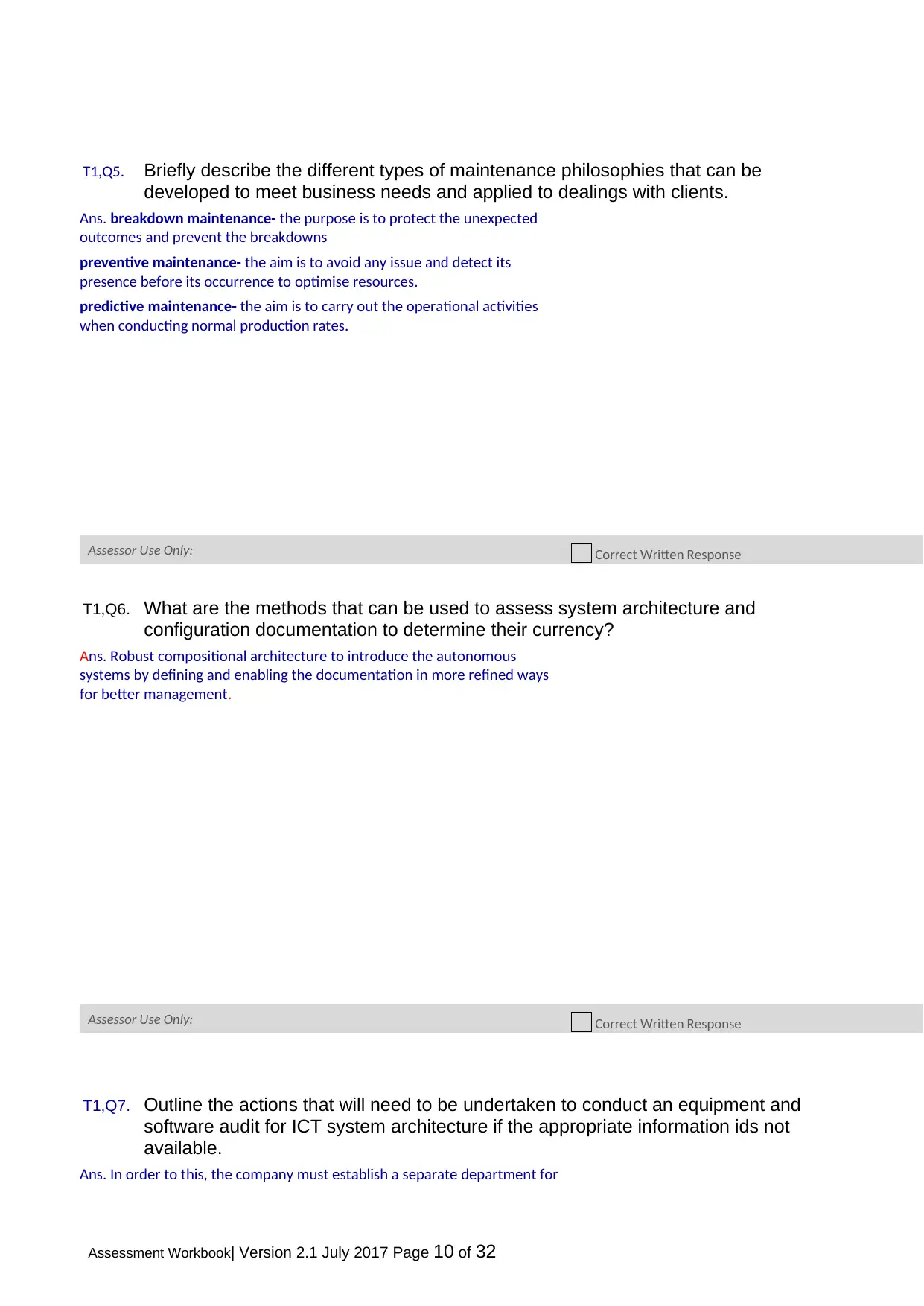
T1,Q5. Briefly describe the different types of maintenance philosophies that can be
developed to meet business needs and applied to dealings with clients.
Ans. breakdown maintenance- the purpose is to protect the unexpected
outcomes and prevent the breakdowns
preventive maintenance- the aim is to avoid any issue and detect its
presence before its occurrence to optimise resources.
predictive maintenance- the aim is to carry out the operational activities
when conducting normal production rates.
Assessor Use Only: Correct Written Response
T1,Q6. What are the methods that can be used to assess system architecture and
configuration documentation to determine their currency?
Ans. Robust compositional architecture to introduce the autonomous
systems by defining and enabling the documentation in more refined ways
for better management.
Assessor Use Only: Correct Written Response
T1,Q7. Outline the actions that will need to be undertaken to conduct an equipment and
software audit for ICT system architecture if the appropriate information ids not
available.
Ans. In order to this, the company must establish a separate department for
Assessment Workbook| Version 2.1 July 2017 Page 10 of 32
developed to meet business needs and applied to dealings with clients.
Ans. breakdown maintenance- the purpose is to protect the unexpected
outcomes and prevent the breakdowns
preventive maintenance- the aim is to avoid any issue and detect its
presence before its occurrence to optimise resources.
predictive maintenance- the aim is to carry out the operational activities
when conducting normal production rates.
Assessor Use Only: Correct Written Response
T1,Q6. What are the methods that can be used to assess system architecture and
configuration documentation to determine their currency?
Ans. Robust compositional architecture to introduce the autonomous
systems by defining and enabling the documentation in more refined ways
for better management.
Assessor Use Only: Correct Written Response
T1,Q7. Outline the actions that will need to be undertaken to conduct an equipment and
software audit for ICT system architecture if the appropriate information ids not
available.
Ans. In order to this, the company must establish a separate department for
Assessment Workbook| Version 2.1 July 2017 Page 10 of 32
Secure Best Marks with AI Grader
Need help grading? Try our AI Grader for instant feedback on your assignments.
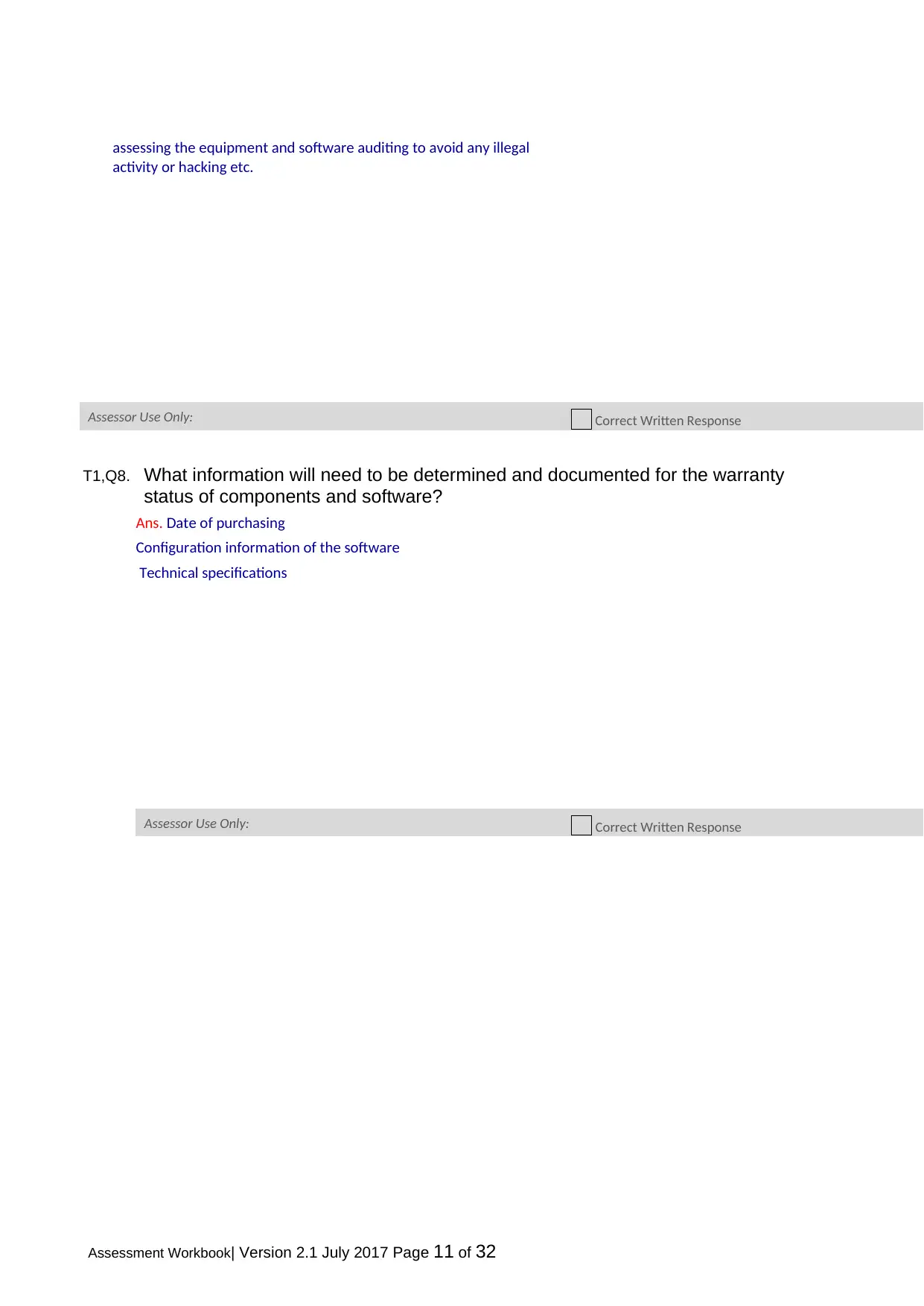
assessing the equipment and software auditing to avoid any illegal
activity or hacking etc.
Assessor Use Only: Correct Written Response
T1,Q8. What information will need to be determined and documented for the warranty
status of components and software?
Ans. Date of purchasing
Configuration information of the software
Technical specifications
Assessor Use Only: Correct Written Response
Assessment Workbook| Version 2.1 July 2017 Page 11 of 32
activity or hacking etc.
Assessor Use Only: Correct Written Response
T1,Q8. What information will need to be determined and documented for the warranty
status of components and software?
Ans. Date of purchasing
Configuration information of the software
Technical specifications
Assessor Use Only: Correct Written Response
Assessment Workbook| Version 2.1 July 2017 Page 11 of 32
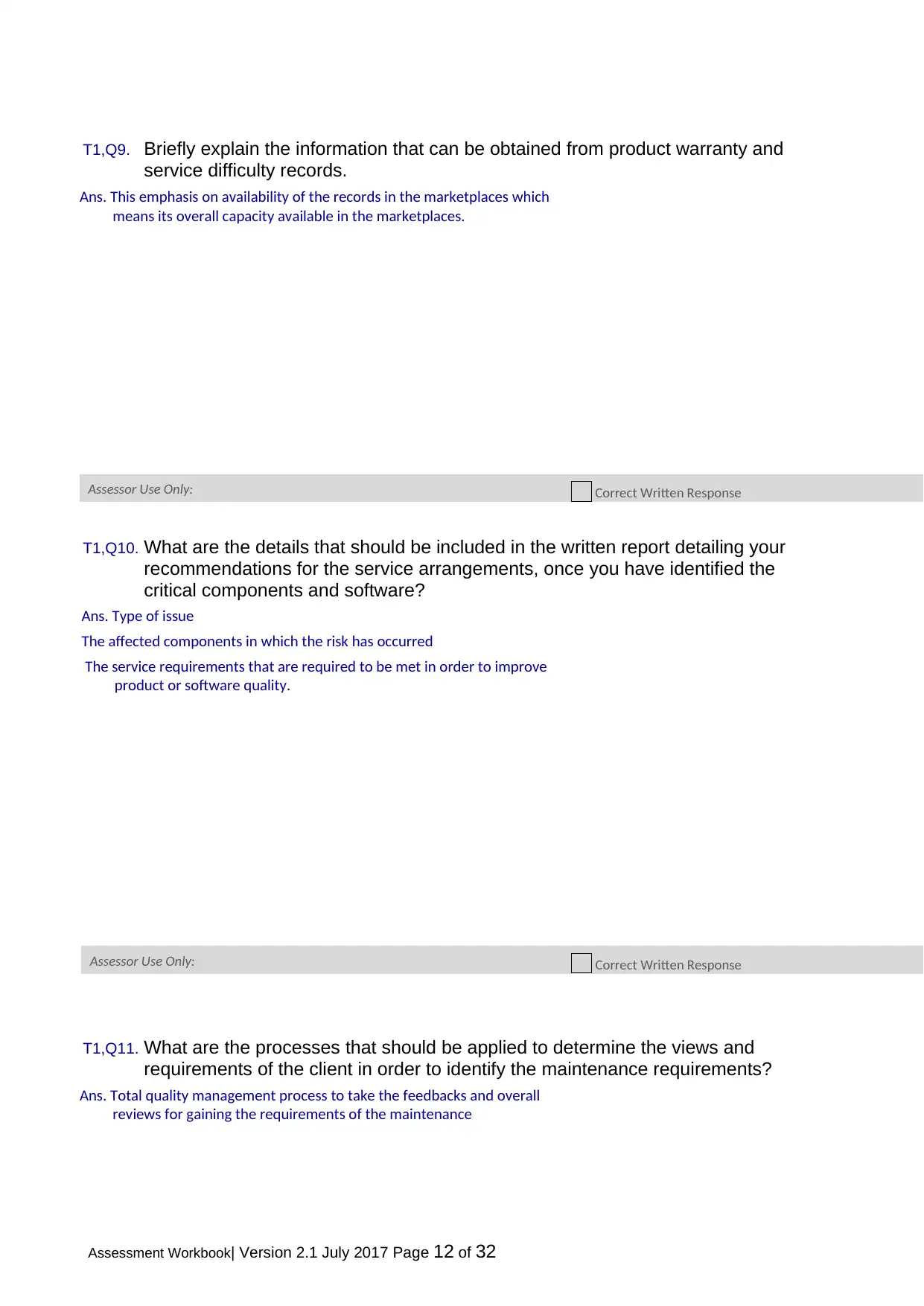
T1,Q9. Briefly explain the information that can be obtained from product warranty and
service difficulty records.
Ans. This emphasis on availability of the records in the marketplaces which
means its overall capacity available in the marketplaces.
Assessor Use Only: Correct Written Response
T1,Q10. What are the details that should be included in the written report detailing your
recommendations for the service arrangements, once you have identified the
critical components and software?
Ans. Type of issue
The affected components in which the risk has occurred
The service requirements that are required to be met in order to improve
product or software quality.
Assessor Use Only: Correct Written Response
T1,Q11. What are the processes that should be applied to determine the views and
requirements of the client in order to identify the maintenance requirements?
Ans. Total quality management process to take the feedbacks and overall
reviews for gaining the requirements of the maintenance
Assessment Workbook| Version 2.1 July 2017 Page 12 of 32
service difficulty records.
Ans. This emphasis on availability of the records in the marketplaces which
means its overall capacity available in the marketplaces.
Assessor Use Only: Correct Written Response
T1,Q10. What are the details that should be included in the written report detailing your
recommendations for the service arrangements, once you have identified the
critical components and software?
Ans. Type of issue
The affected components in which the risk has occurred
The service requirements that are required to be met in order to improve
product or software quality.
Assessor Use Only: Correct Written Response
T1,Q11. What are the processes that should be applied to determine the views and
requirements of the client in order to identify the maintenance requirements?
Ans. Total quality management process to take the feedbacks and overall
reviews for gaining the requirements of the maintenance
Assessment Workbook| Version 2.1 July 2017 Page 12 of 32
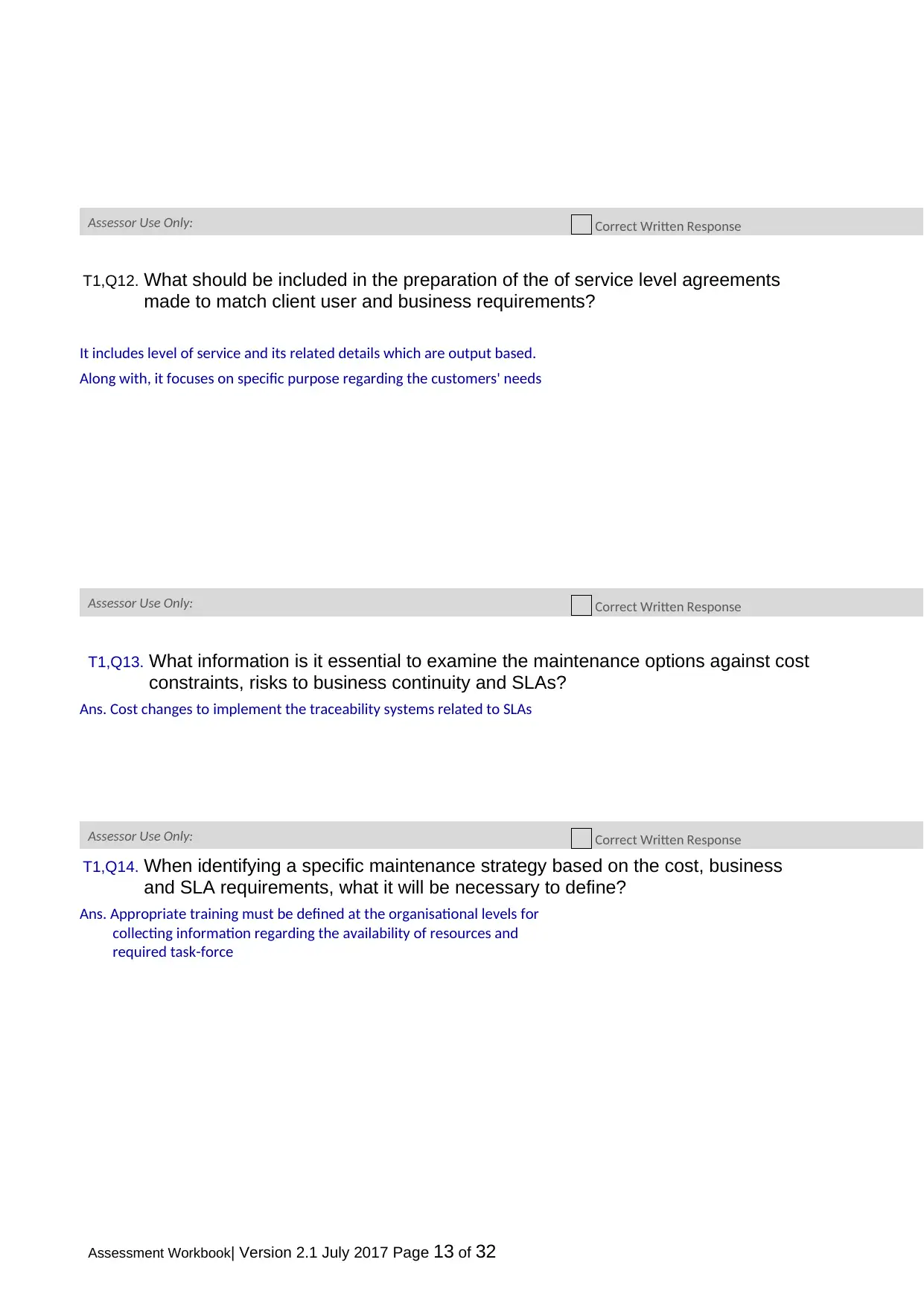
Assessor Use Only: Correct Written Response
T1,Q12. What should be included in the preparation of the of service level agreements
made to match client user and business requirements?
It includes level of service and its related details which are output based.
Along with, it focuses on specific purpose regarding the customers' needs
Assessor Use Only: Correct Written Response
T1,Q13. What information is it essential to examine the maintenance options against cost
constraints, risks to business continuity and SLAs?
Ans. Cost changes to implement the traceability systems related to SLAs
Assessor Use Only: Correct Written Response
T1,Q14. When identifying a specific maintenance strategy based on the cost, business
and SLA requirements, what it will be necessary to define?
Ans. Appropriate training must be defined at the organisational levels for
collecting information regarding the availability of resources and
required task-force
Assessment Workbook| Version 2.1 July 2017 Page 13 of 32
T1,Q12. What should be included in the preparation of the of service level agreements
made to match client user and business requirements?
It includes level of service and its related details which are output based.
Along with, it focuses on specific purpose regarding the customers' needs
Assessor Use Only: Correct Written Response
T1,Q13. What information is it essential to examine the maintenance options against cost
constraints, risks to business continuity and SLAs?
Ans. Cost changes to implement the traceability systems related to SLAs
Assessor Use Only: Correct Written Response
T1,Q14. When identifying a specific maintenance strategy based on the cost, business
and SLA requirements, what it will be necessary to define?
Ans. Appropriate training must be defined at the organisational levels for
collecting information regarding the availability of resources and
required task-force
Assessment Workbook| Version 2.1 July 2017 Page 13 of 32
Paraphrase This Document
Need a fresh take? Get an instant paraphrase of this document with our AI Paraphraser
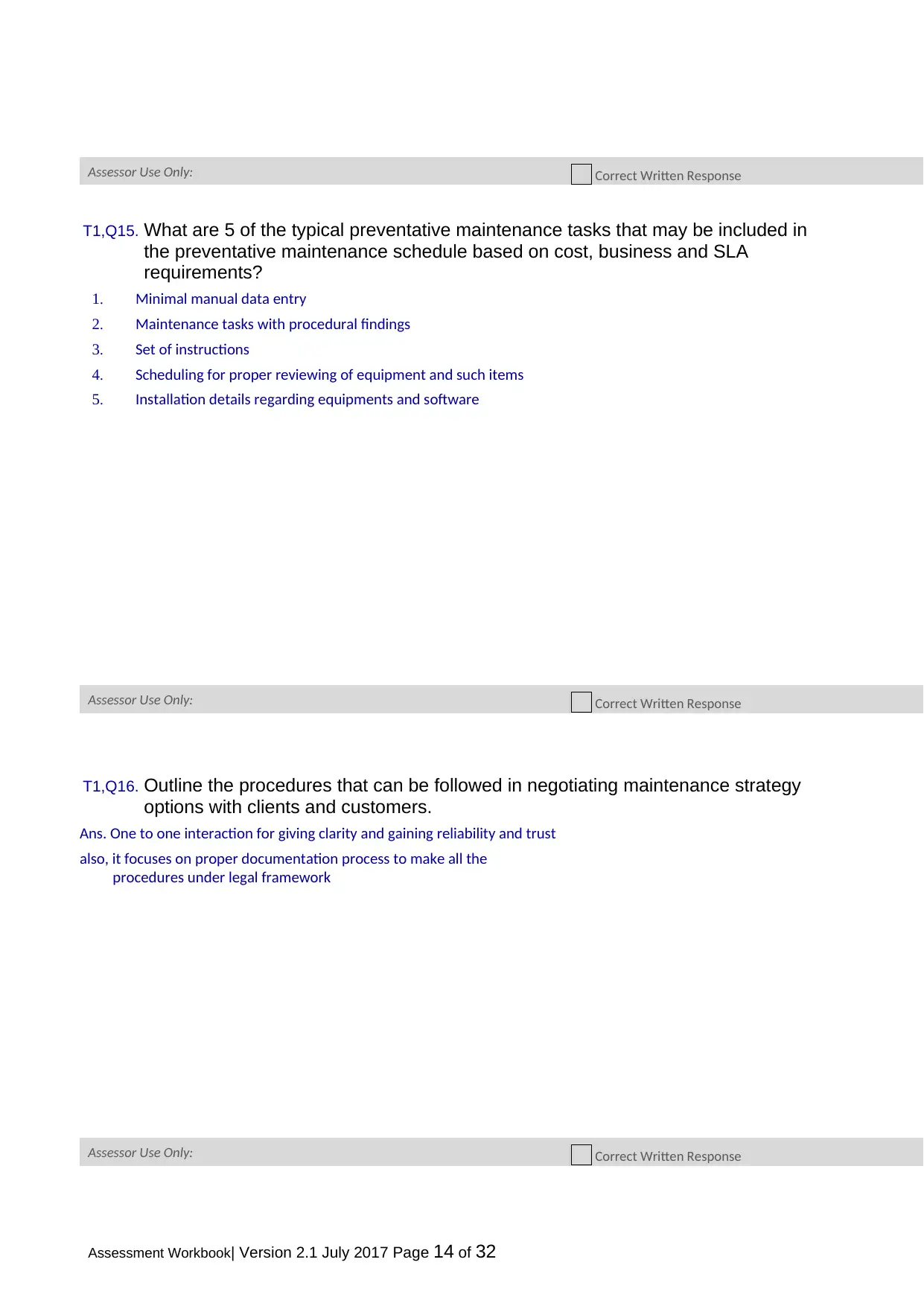
Assessor Use Only: Correct Written Response
T1,Q15. What are 5 of the typical preventative maintenance tasks that may be included in
the preventative maintenance schedule based on cost, business and SLA
requirements?
1. Minimal manual data entry
2. Maintenance tasks with procedural findings
3. Set of instructions
4. Scheduling for proper reviewing of equipment and such items
5. Installation details regarding equipments and software
Assessor Use Only: Correct Written Response
T1,Q16. Outline the procedures that can be followed in negotiating maintenance strategy
options with clients and customers.
Ans. One to one interaction for giving clarity and gaining reliability and trust
also, it focuses on proper documentation process to make all the
procedures under legal framework
Assessor Use Only: Correct Written Response
Assessment Workbook| Version 2.1 July 2017 Page 14 of 32
T1,Q15. What are 5 of the typical preventative maintenance tasks that may be included in
the preventative maintenance schedule based on cost, business and SLA
requirements?
1. Minimal manual data entry
2. Maintenance tasks with procedural findings
3. Set of instructions
4. Scheduling for proper reviewing of equipment and such items
5. Installation details regarding equipments and software
Assessor Use Only: Correct Written Response
T1,Q16. Outline the procedures that can be followed in negotiating maintenance strategy
options with clients and customers.
Ans. One to one interaction for giving clarity and gaining reliability and trust
also, it focuses on proper documentation process to make all the
procedures under legal framework
Assessor Use Only: Correct Written Response
Assessment Workbook| Version 2.1 July 2017 Page 14 of 32
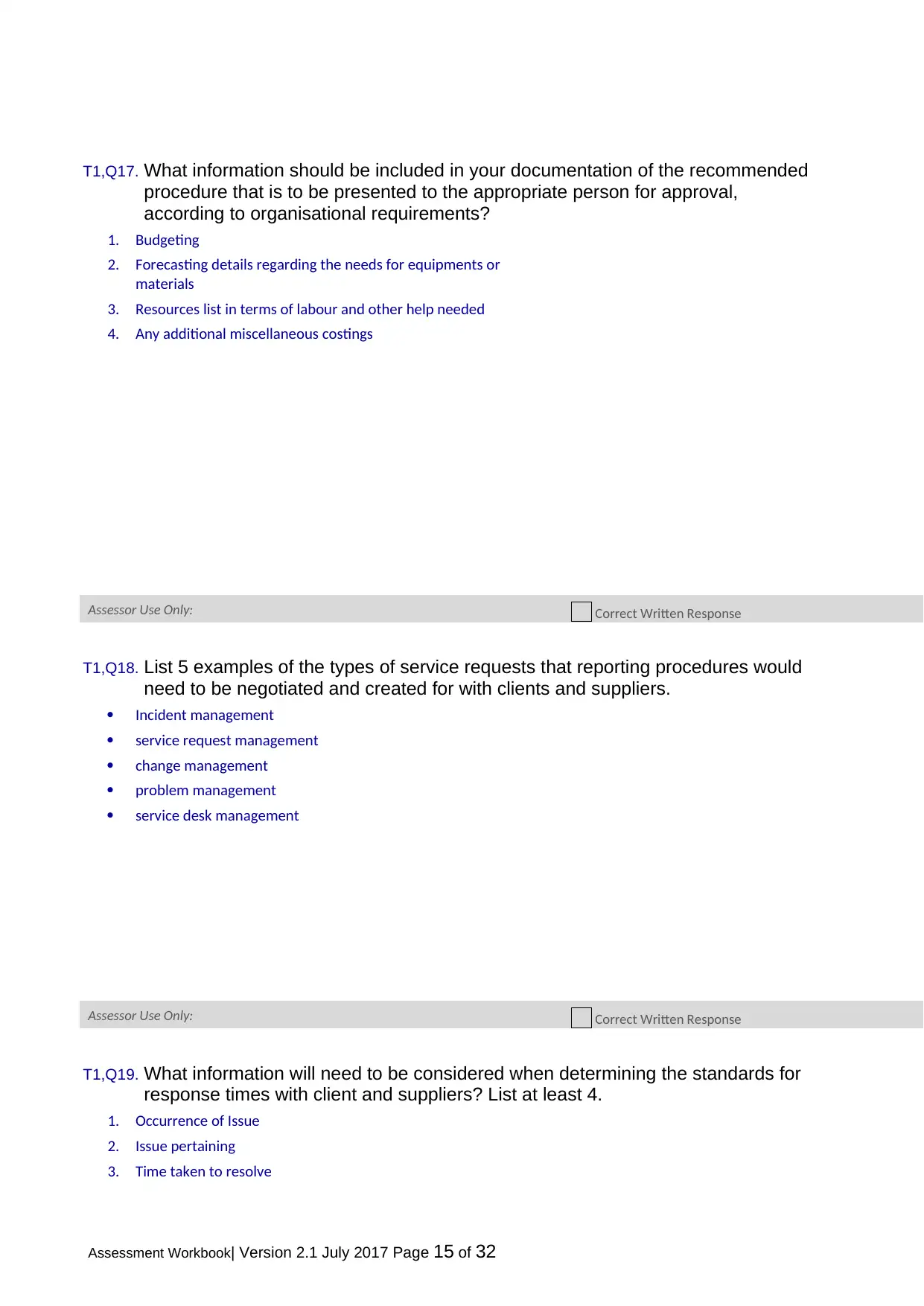
T1,Q17. What information should be included in your documentation of the recommended
procedure that is to be presented to the appropriate person for approval,
according to organisational requirements?
1. Budgeting
2. Forecasting details regarding the needs for equipments or
materials
3. Resources list in terms of labour and other help needed
4. Any additional miscellaneous costings
Assessor Use Only: Correct Written Response
T1,Q18. List 5 examples of the types of service requests that reporting procedures would
need to be negotiated and created for with clients and suppliers.
Incident management
service request management
change management
problem management
service desk management
Assessor Use Only: Correct Written Response
T1,Q19. What information will need to be considered when determining the standards for
response times with client and suppliers? List at least 4.
1. Occurrence of Issue
2. Issue pertaining
3. Time taken to resolve
Assessment Workbook| Version 2.1 July 2017 Page 15 of 32
procedure that is to be presented to the appropriate person for approval,
according to organisational requirements?
1. Budgeting
2. Forecasting details regarding the needs for equipments or
materials
3. Resources list in terms of labour and other help needed
4. Any additional miscellaneous costings
Assessor Use Only: Correct Written Response
T1,Q18. List 5 examples of the types of service requests that reporting procedures would
need to be negotiated and created for with clients and suppliers.
Incident management
service request management
change management
problem management
service desk management
Assessor Use Only: Correct Written Response
T1,Q19. What information will need to be considered when determining the standards for
response times with client and suppliers? List at least 4.
1. Occurrence of Issue
2. Issue pertaining
3. Time taken to resolve
Assessment Workbook| Version 2.1 July 2017 Page 15 of 32
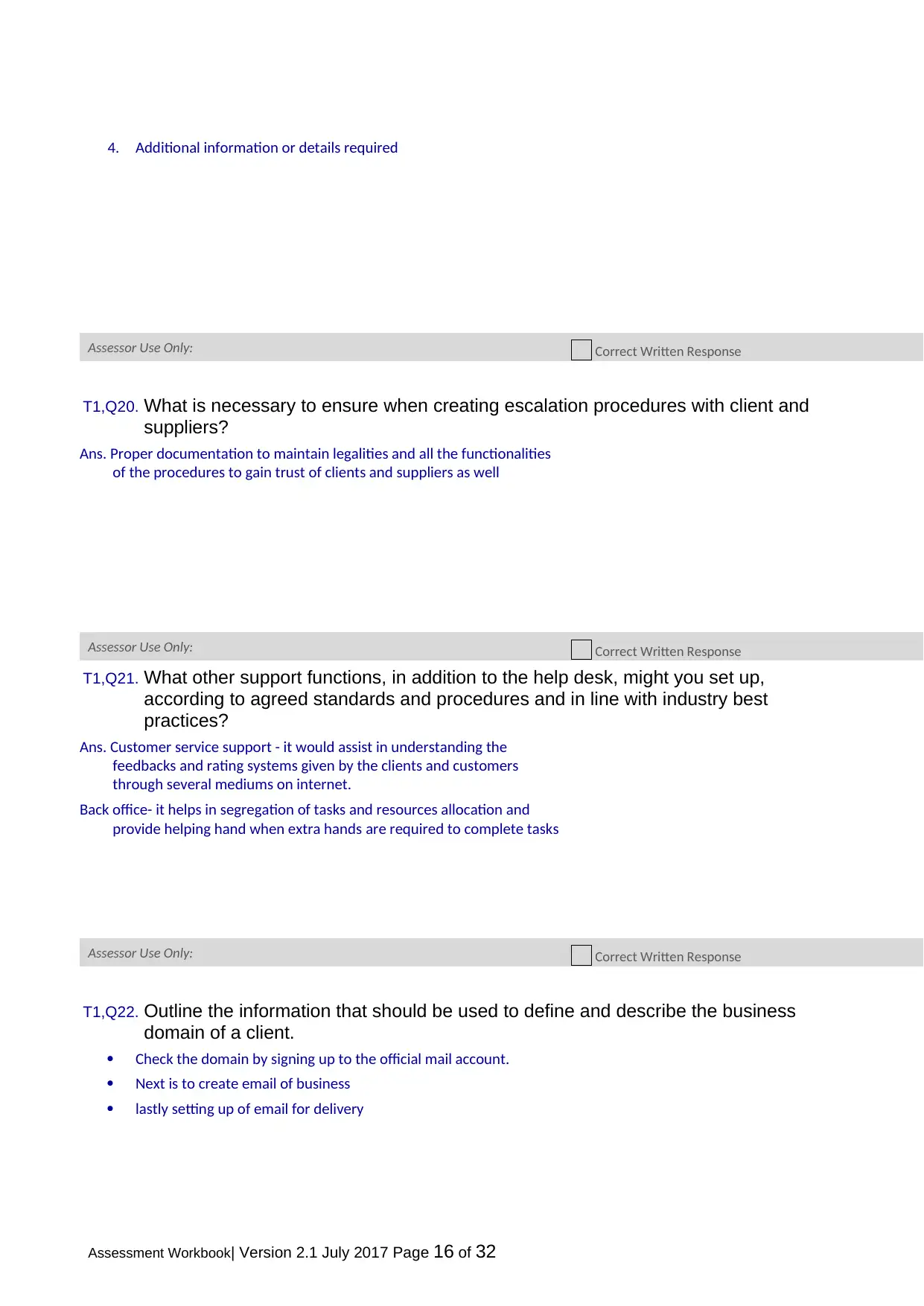
4. Additional information or details required
Assessor Use Only: Correct Written Response
T1,Q20. What is necessary to ensure when creating escalation procedures with client and
suppliers?
Ans. Proper documentation to maintain legalities and all the functionalities
of the procedures to gain trust of clients and suppliers as well
Assessor Use Only: Correct Written Response
T1,Q21. What other support functions, in addition to the help desk, might you set up,
according to agreed standards and procedures and in line with industry best
practices?
Ans. Customer service support - it would assist in understanding the
feedbacks and rating systems given by the clients and customers
through several mediums on internet.
Back office- it helps in segregation of tasks and resources allocation and
provide helping hand when extra hands are required to complete tasks
Assessor Use Only: Correct Written Response
T1,Q22. Outline the information that should be used to define and describe the business
domain of a client.
Check the domain by signing up to the official mail account.
Next is to create email of business
lastly setting up of email for delivery
Assessment Workbook| Version 2.1 July 2017 Page 16 of 32
Assessor Use Only: Correct Written Response
T1,Q20. What is necessary to ensure when creating escalation procedures with client and
suppliers?
Ans. Proper documentation to maintain legalities and all the functionalities
of the procedures to gain trust of clients and suppliers as well
Assessor Use Only: Correct Written Response
T1,Q21. What other support functions, in addition to the help desk, might you set up,
according to agreed standards and procedures and in line with industry best
practices?
Ans. Customer service support - it would assist in understanding the
feedbacks and rating systems given by the clients and customers
through several mediums on internet.
Back office- it helps in segregation of tasks and resources allocation and
provide helping hand when extra hands are required to complete tasks
Assessor Use Only: Correct Written Response
T1,Q22. Outline the information that should be used to define and describe the business
domain of a client.
Check the domain by signing up to the official mail account.
Next is to create email of business
lastly setting up of email for delivery
Assessment Workbook| Version 2.1 July 2017 Page 16 of 32
Secure Best Marks with AI Grader
Need help grading? Try our AI Grader for instant feedback on your assignments.
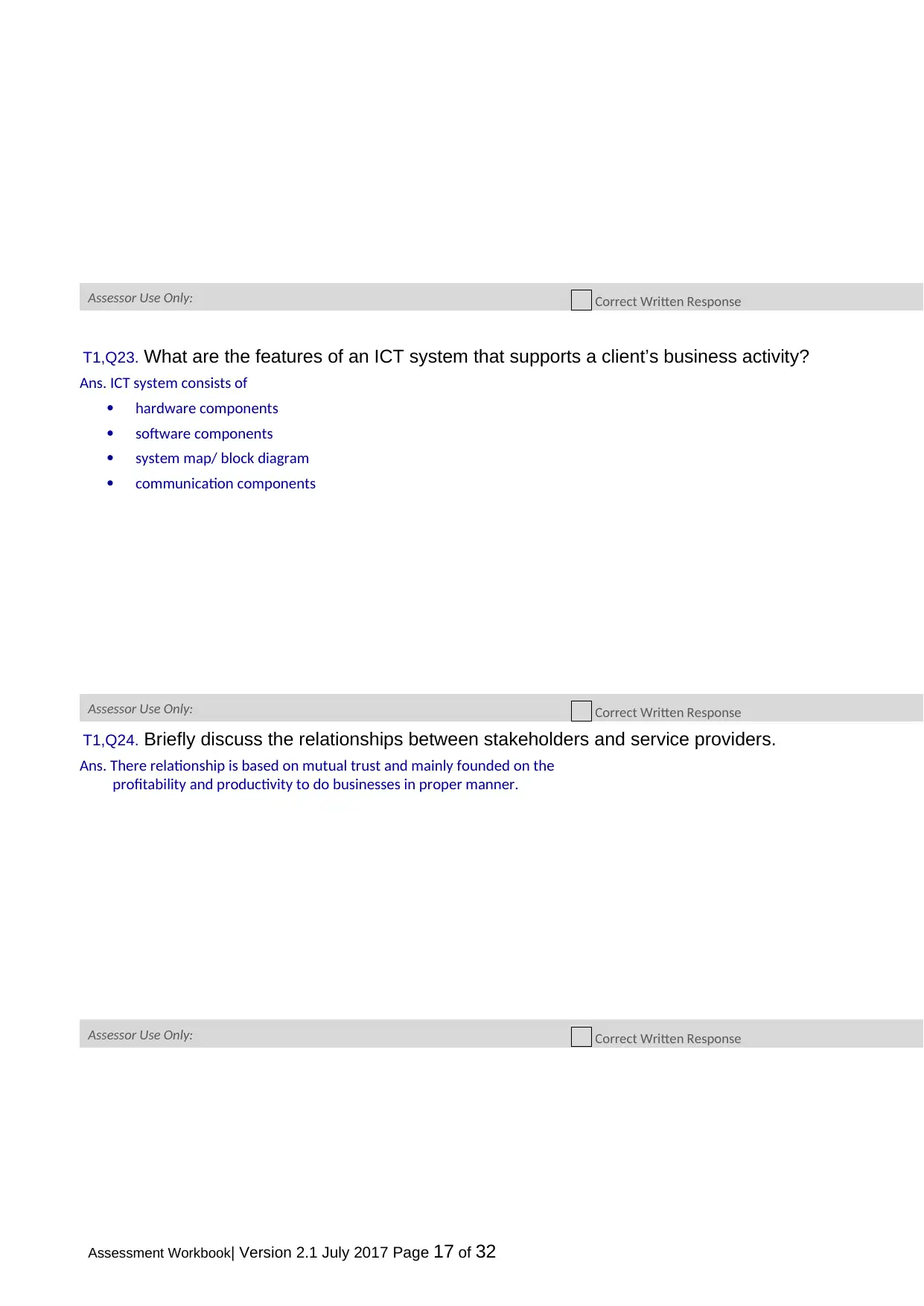
Assessor Use Only: Correct Written Response
T1,Q23. What are the features of an ICT system that supports a client’s business activity?
Ans. ICT system consists of
hardware components
software components
system map/ block diagram
communication components
Assessor Use Only: Correct Written Response
T1,Q24. Briefly discuss the relationships between stakeholders and service providers.
Ans. There relationship is based on mutual trust and mainly founded on the
profitability and productivity to do businesses in proper manner.
Assessor Use Only: Correct Written Response
Assessment Workbook| Version 2.1 July 2017 Page 17 of 32
T1,Q23. What are the features of an ICT system that supports a client’s business activity?
Ans. ICT system consists of
hardware components
software components
system map/ block diagram
communication components
Assessor Use Only: Correct Written Response
T1,Q24. Briefly discuss the relationships between stakeholders and service providers.
Ans. There relationship is based on mutual trust and mainly founded on the
profitability and productivity to do businesses in proper manner.
Assessor Use Only: Correct Written Response
Assessment Workbook| Version 2.1 July 2017 Page 17 of 32
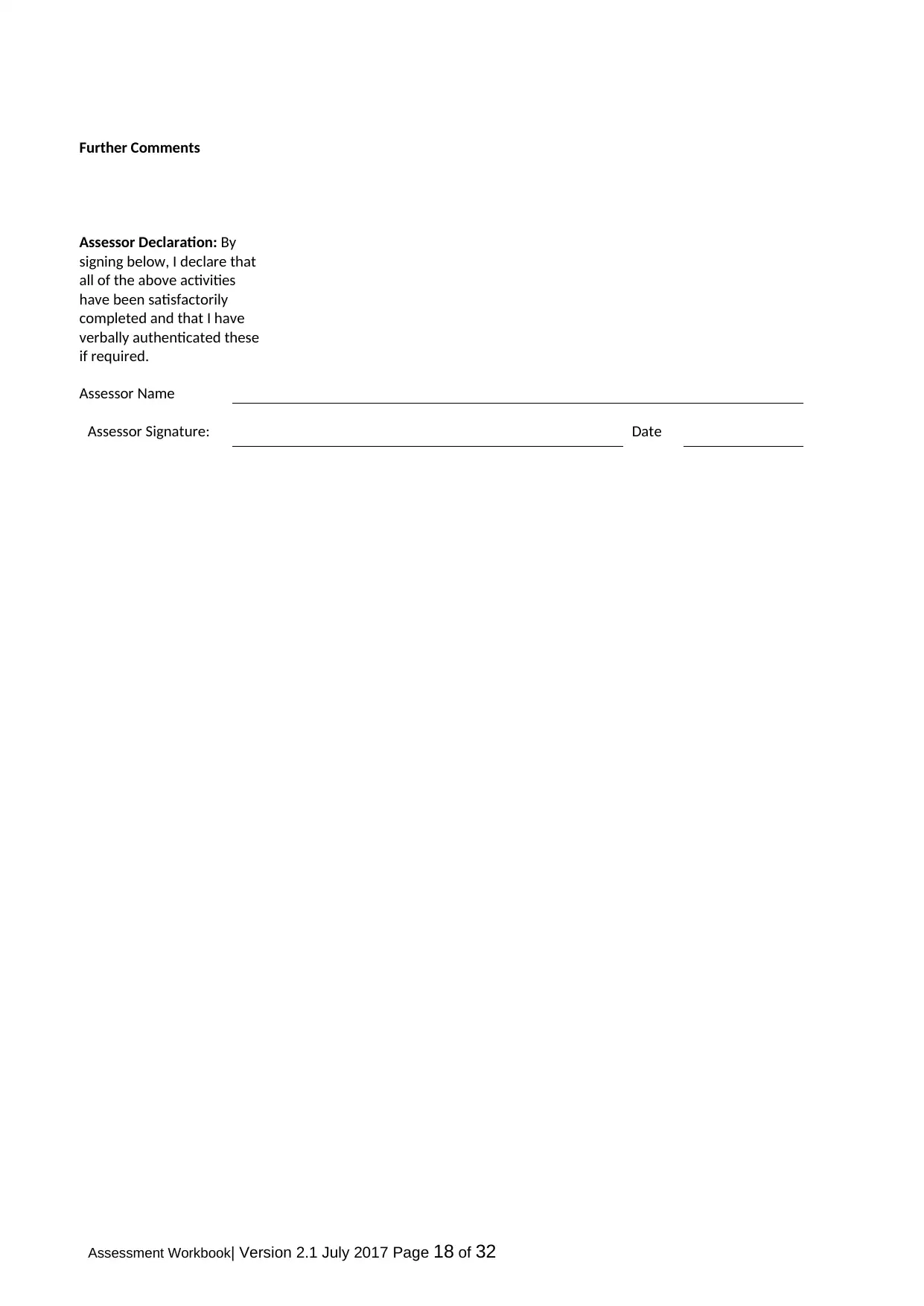
Further Comments
Assessor Declaration: By
signing below, I declare that
all of the above activities
have been satisfactorily
completed and that I have
verbally authenticated these
if required.
Assessor Name
Assessor Signature: Date
Assessment Workbook| Version 2.1 July 2017 Page 18 of 32
Assessor Declaration: By
signing below, I declare that
all of the above activities
have been satisfactorily
completed and that I have
verbally authenticated these
if required.
Assessor Name
Assessor Signature: Date
Assessment Workbook| Version 2.1 July 2017 Page 18 of 32
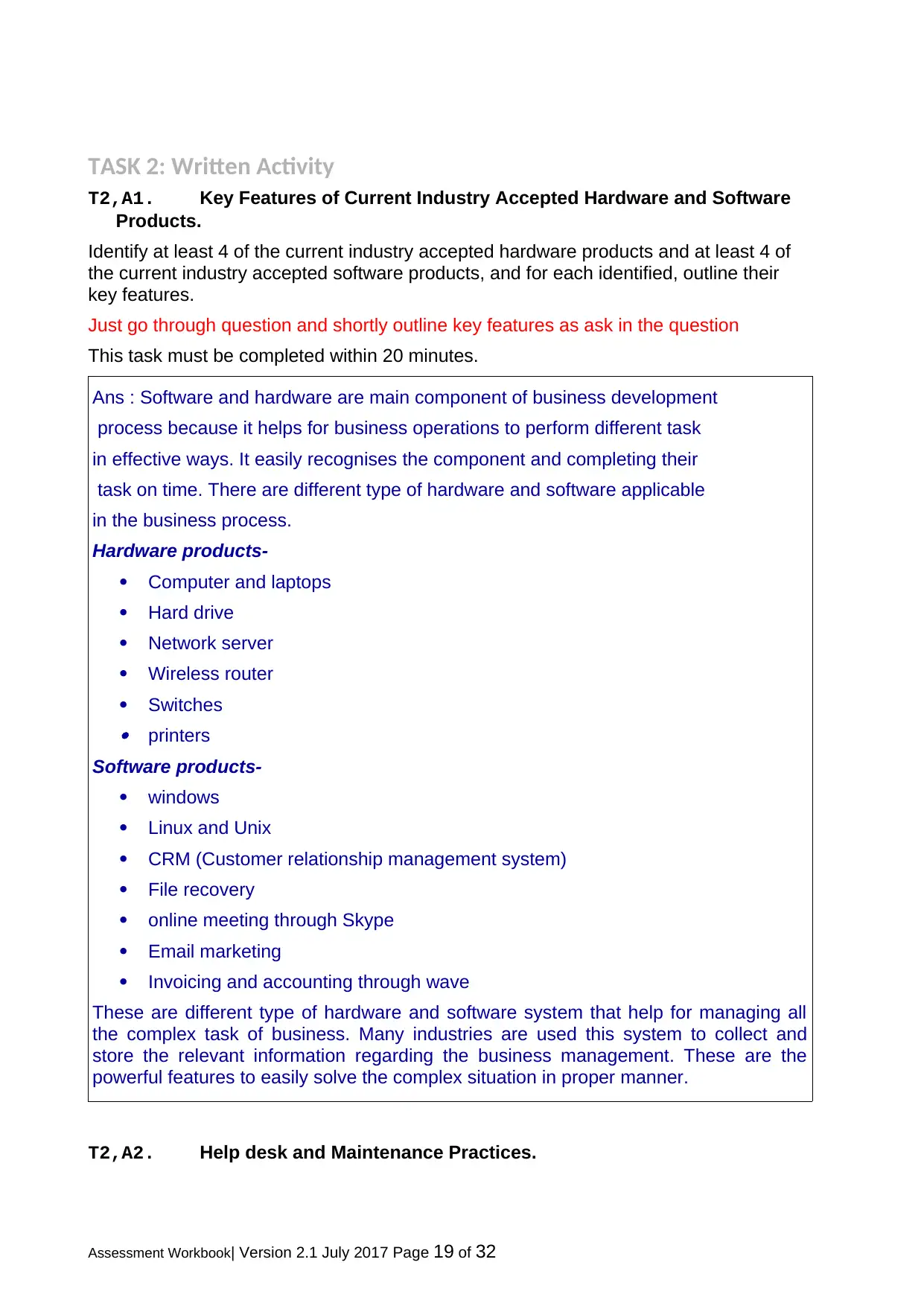
TASK 2: Written Activity
T2,A1. Key Features of Current Industry Accepted Hardware and Software
Products.
Identify at least 4 of the current industry accepted hardware products and at least 4 of
the current industry accepted software products, and for each identified, outline their
key features.
Just go through question and shortly outline key features as ask in the question
This task must be completed within 20 minutes.
Ans : Software and hardware are main component of business development
process because it helps for business operations to perform different task
in effective ways. It easily recognises the component and completing their
task on time. There are different type of hardware and software applicable
in the business process.
Hardware products-
Computer and laptops
Hard drive
Network server
Wireless router
Switches printers
Software products-
windows
Linux and Unix
CRM (Customer relationship management system)
File recovery
online meeting through Skype
Email marketing
Invoicing and accounting through wave
These are different type of hardware and software system that help for managing all
the complex task of business. Many industries are used this system to collect and
store the relevant information regarding the business management. These are the
powerful features to easily solve the complex situation in proper manner.
T2,A2. Help desk and Maintenance Practices.
Assessment Workbook| Version 2.1 July 2017 Page 19 of 32
T2,A1. Key Features of Current Industry Accepted Hardware and Software
Products.
Identify at least 4 of the current industry accepted hardware products and at least 4 of
the current industry accepted software products, and for each identified, outline their
key features.
Just go through question and shortly outline key features as ask in the question
This task must be completed within 20 minutes.
Ans : Software and hardware are main component of business development
process because it helps for business operations to perform different task
in effective ways. It easily recognises the component and completing their
task on time. There are different type of hardware and software applicable
in the business process.
Hardware products-
Computer and laptops
Hard drive
Network server
Wireless router
Switches printers
Software products-
windows
Linux and Unix
CRM (Customer relationship management system)
File recovery
online meeting through Skype
Email marketing
Invoicing and accounting through wave
These are different type of hardware and software system that help for managing all
the complex task of business. Many industries are used this system to collect and
store the relevant information regarding the business management. These are the
powerful features to easily solve the complex situation in proper manner.
T2,A2. Help desk and Maintenance Practices.
Assessment Workbook| Version 2.1 July 2017 Page 19 of 32
Paraphrase This Document
Need a fresh take? Get an instant paraphrase of this document with our AI Paraphraser
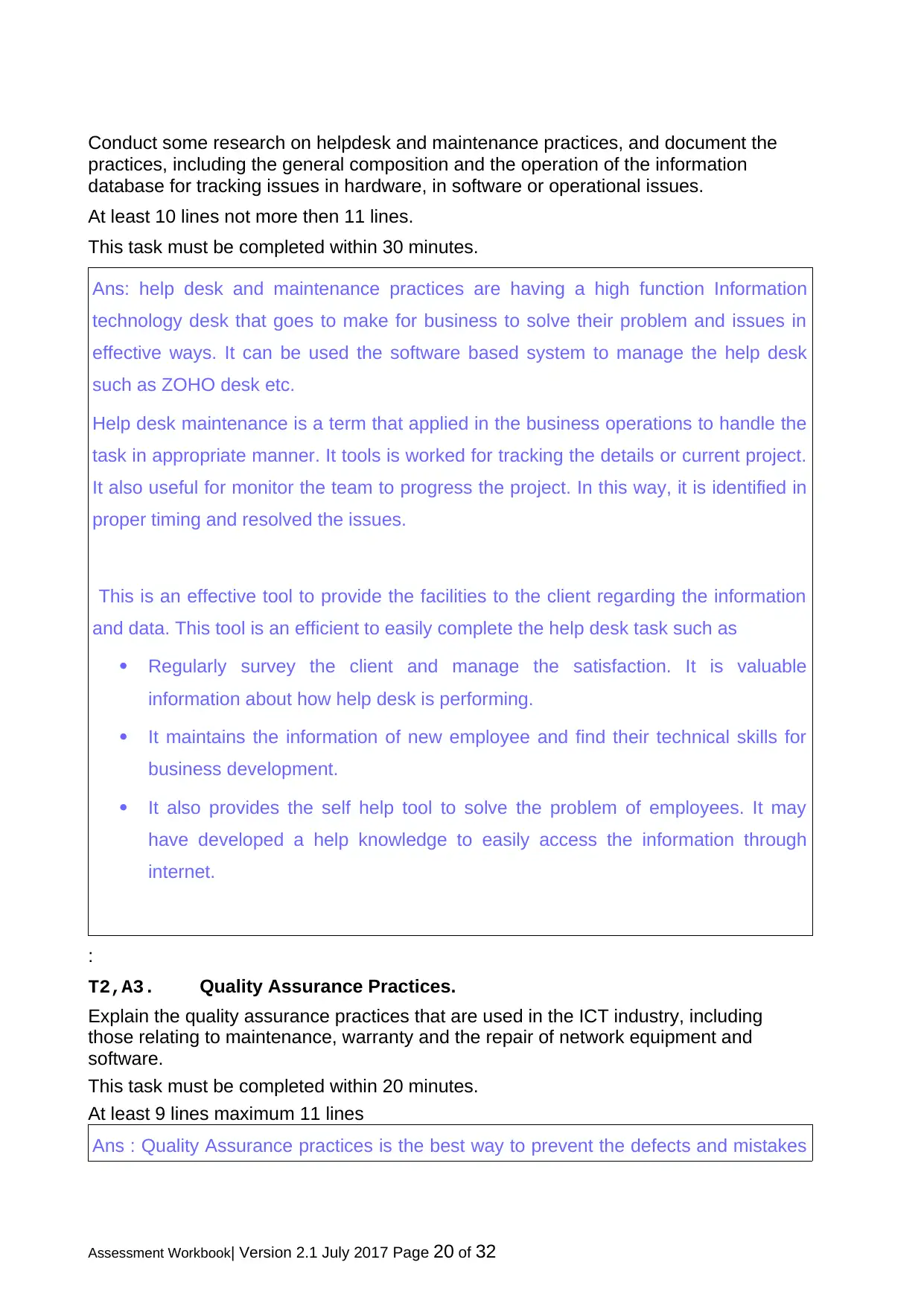
Conduct some research on helpdesk and maintenance practices, and document the
practices, including the general composition and the operation of the information
database for tracking issues in hardware, in software or operational issues.
At least 10 lines not more then 11 lines.
This task must be completed within 30 minutes.
Ans: help desk and maintenance practices are having a high function Information
technology desk that goes to make for business to solve their problem and issues in
effective ways. It can be used the software based system to manage the help desk
such as ZOHO desk etc.
Help desk maintenance is a term that applied in the business operations to handle the
task in appropriate manner. It tools is worked for tracking the details or current project.
It also useful for monitor the team to progress the project. In this way, it is identified in
proper timing and resolved the issues.
This is an effective tool to provide the facilities to the client regarding the information
and data. This tool is an efficient to easily complete the help desk task such as
Regularly survey the client and manage the satisfaction. It is valuable
information about how help desk is performing.
It maintains the information of new employee and find their technical skills for
business development.
It also provides the self help tool to solve the problem of employees. It may
have developed a help knowledge to easily access the information through
internet.
:
T2,A3. Quality Assurance Practices.
Explain the quality assurance practices that are used in the ICT industry, including
those relating to maintenance, warranty and the repair of network equipment and
software.
This task must be completed within 20 minutes.
At least 9 lines maximum 11 lines
Ans : Quality Assurance practices is the best way to prevent the defects and mistakes
Assessment Workbook| Version 2.1 July 2017 Page 20 of 32
practices, including the general composition and the operation of the information
database for tracking issues in hardware, in software or operational issues.
At least 10 lines not more then 11 lines.
This task must be completed within 30 minutes.
Ans: help desk and maintenance practices are having a high function Information
technology desk that goes to make for business to solve their problem and issues in
effective ways. It can be used the software based system to manage the help desk
such as ZOHO desk etc.
Help desk maintenance is a term that applied in the business operations to handle the
task in appropriate manner. It tools is worked for tracking the details or current project.
It also useful for monitor the team to progress the project. In this way, it is identified in
proper timing and resolved the issues.
This is an effective tool to provide the facilities to the client regarding the information
and data. This tool is an efficient to easily complete the help desk task such as
Regularly survey the client and manage the satisfaction. It is valuable
information about how help desk is performing.
It maintains the information of new employee and find their technical skills for
business development.
It also provides the self help tool to solve the problem of employees. It may
have developed a help knowledge to easily access the information through
internet.
:
T2,A3. Quality Assurance Practices.
Explain the quality assurance practices that are used in the ICT industry, including
those relating to maintenance, warranty and the repair of network equipment and
software.
This task must be completed within 20 minutes.
At least 9 lines maximum 11 lines
Ans : Quality Assurance practices is the best way to prevent the defects and mistakes
Assessment Workbook| Version 2.1 July 2017 Page 20 of 32
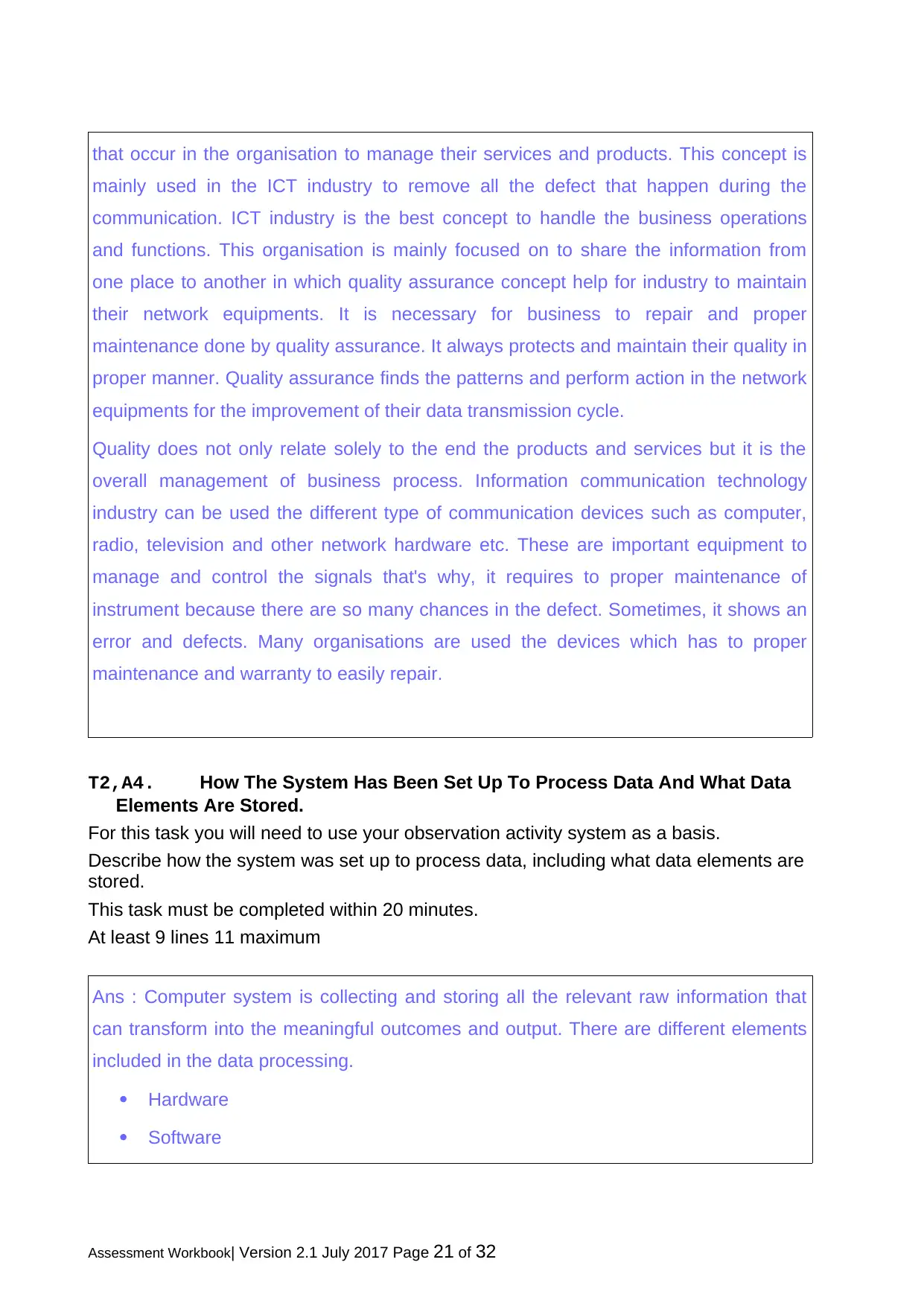
that occur in the organisation to manage their services and products. This concept is
mainly used in the ICT industry to remove all the defect that happen during the
communication. ICT industry is the best concept to handle the business operations
and functions. This organisation is mainly focused on to share the information from
one place to another in which quality assurance concept help for industry to maintain
their network equipments. It is necessary for business to repair and proper
maintenance done by quality assurance. It always protects and maintain their quality in
proper manner. Quality assurance finds the patterns and perform action in the network
equipments for the improvement of their data transmission cycle.
Quality does not only relate solely to the end the products and services but it is the
overall management of business process. Information communication technology
industry can be used the different type of communication devices such as computer,
radio, television and other network hardware etc. These are important equipment to
manage and control the signals that's why, it requires to proper maintenance of
instrument because there are so many chances in the defect. Sometimes, it shows an
error and defects. Many organisations are used the devices which has to proper
maintenance and warranty to easily repair.
T2,A4. How The System Has Been Set Up To Process Data And What Data
Elements Are Stored.
For this task you will need to use your observation activity system as a basis.
Describe how the system was set up to process data, including what data elements are
stored.
This task must be completed within 20 minutes.
At least 9 lines 11 maximum
Ans : Computer system is collecting and storing all the relevant raw information that
can transform into the meaningful outcomes and output. There are different elements
included in the data processing.
Hardware
Software
Assessment Workbook| Version 2.1 July 2017 Page 21 of 32
mainly used in the ICT industry to remove all the defect that happen during the
communication. ICT industry is the best concept to handle the business operations
and functions. This organisation is mainly focused on to share the information from
one place to another in which quality assurance concept help for industry to maintain
their network equipments. It is necessary for business to repair and proper
maintenance done by quality assurance. It always protects and maintain their quality in
proper manner. Quality assurance finds the patterns and perform action in the network
equipments for the improvement of their data transmission cycle.
Quality does not only relate solely to the end the products and services but it is the
overall management of business process. Information communication technology
industry can be used the different type of communication devices such as computer,
radio, television and other network hardware etc. These are important equipment to
manage and control the signals that's why, it requires to proper maintenance of
instrument because there are so many chances in the defect. Sometimes, it shows an
error and defects. Many organisations are used the devices which has to proper
maintenance and warranty to easily repair.
T2,A4. How The System Has Been Set Up To Process Data And What Data
Elements Are Stored.
For this task you will need to use your observation activity system as a basis.
Describe how the system was set up to process data, including what data elements are
stored.
This task must be completed within 20 minutes.
At least 9 lines 11 maximum
Ans : Computer system is collecting and storing all the relevant raw information that
can transform into the meaningful outcomes and output. There are different elements
included in the data processing.
Hardware
Software
Assessment Workbook| Version 2.1 July 2017 Page 21 of 32
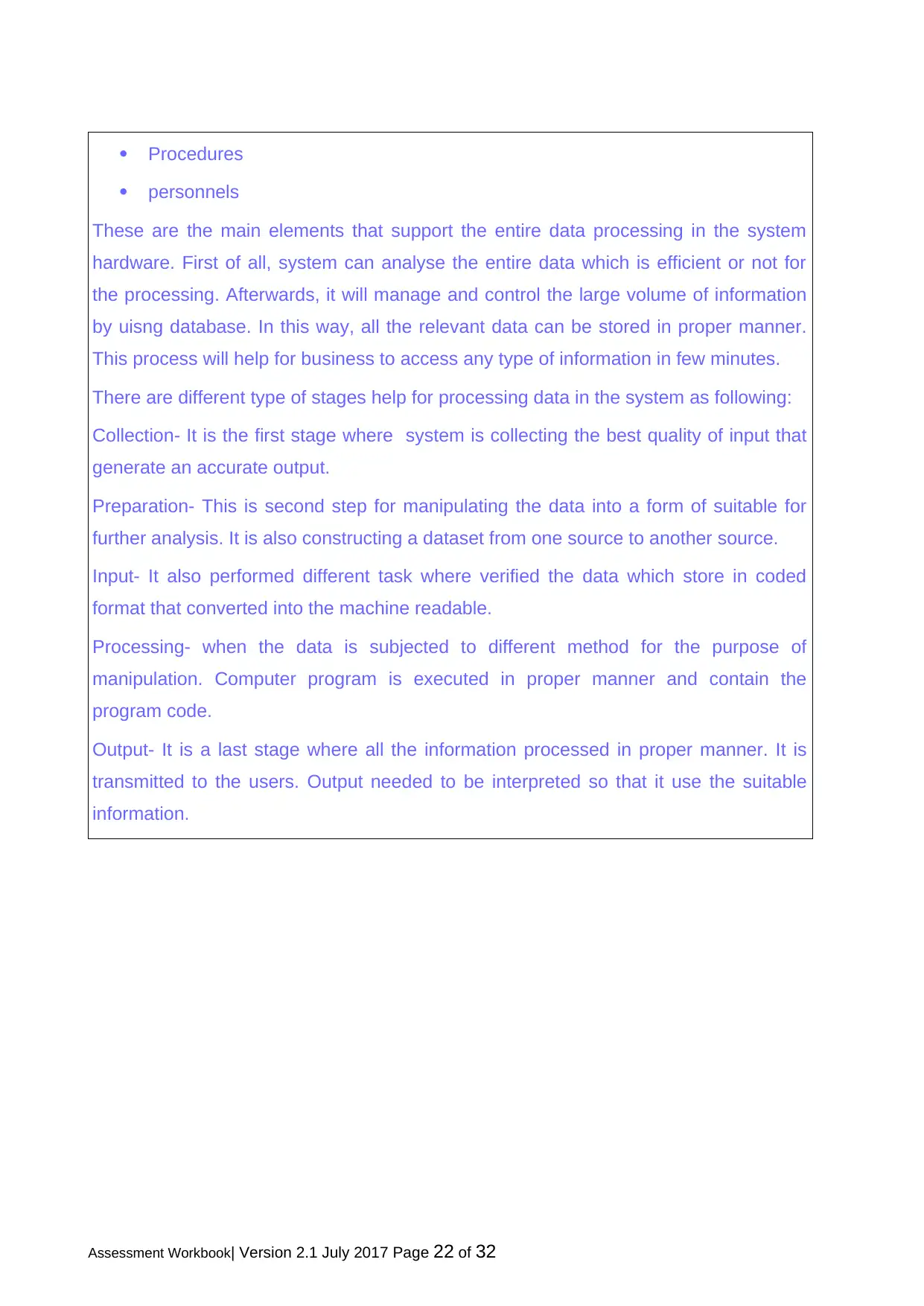
Procedures
personnels
These are the main elements that support the entire data processing in the system
hardware. First of all, system can analyse the entire data which is efficient or not for
the processing. Afterwards, it will manage and control the large volume of information
by uisng database. In this way, all the relevant data can be stored in proper manner.
This process will help for business to access any type of information in few minutes.
There are different type of stages help for processing data in the system as following:
Collection- It is the first stage where system is collecting the best quality of input that
generate an accurate output.
Preparation- This is second step for manipulating the data into a form of suitable for
further analysis. It is also constructing a dataset from one source to another source.
Input- It also performed different task where verified the data which store in coded
format that converted into the machine readable.
Processing- when the data is subjected to different method for the purpose of
manipulation. Computer program is executed in proper manner and contain the
program code.
Output- It is a last stage where all the information processed in proper manner. It is
transmitted to the users. Output needed to be interpreted so that it use the suitable
information.
Assessment Workbook| Version 2.1 July 2017 Page 22 of 32
personnels
These are the main elements that support the entire data processing in the system
hardware. First of all, system can analyse the entire data which is efficient or not for
the processing. Afterwards, it will manage and control the large volume of information
by uisng database. In this way, all the relevant data can be stored in proper manner.
This process will help for business to access any type of information in few minutes.
There are different type of stages help for processing data in the system as following:
Collection- It is the first stage where system is collecting the best quality of input that
generate an accurate output.
Preparation- This is second step for manipulating the data into a form of suitable for
further analysis. It is also constructing a dataset from one source to another source.
Input- It also performed different task where verified the data which store in coded
format that converted into the machine readable.
Processing- when the data is subjected to different method for the purpose of
manipulation. Computer program is executed in proper manner and contain the
program code.
Output- It is a last stage where all the information processed in proper manner. It is
transmitted to the users. Output needed to be interpreted so that it use the suitable
information.
Assessment Workbook| Version 2.1 July 2017 Page 22 of 32
Secure Best Marks with AI Grader
Need help grading? Try our AI Grader for instant feedback on your assignments.
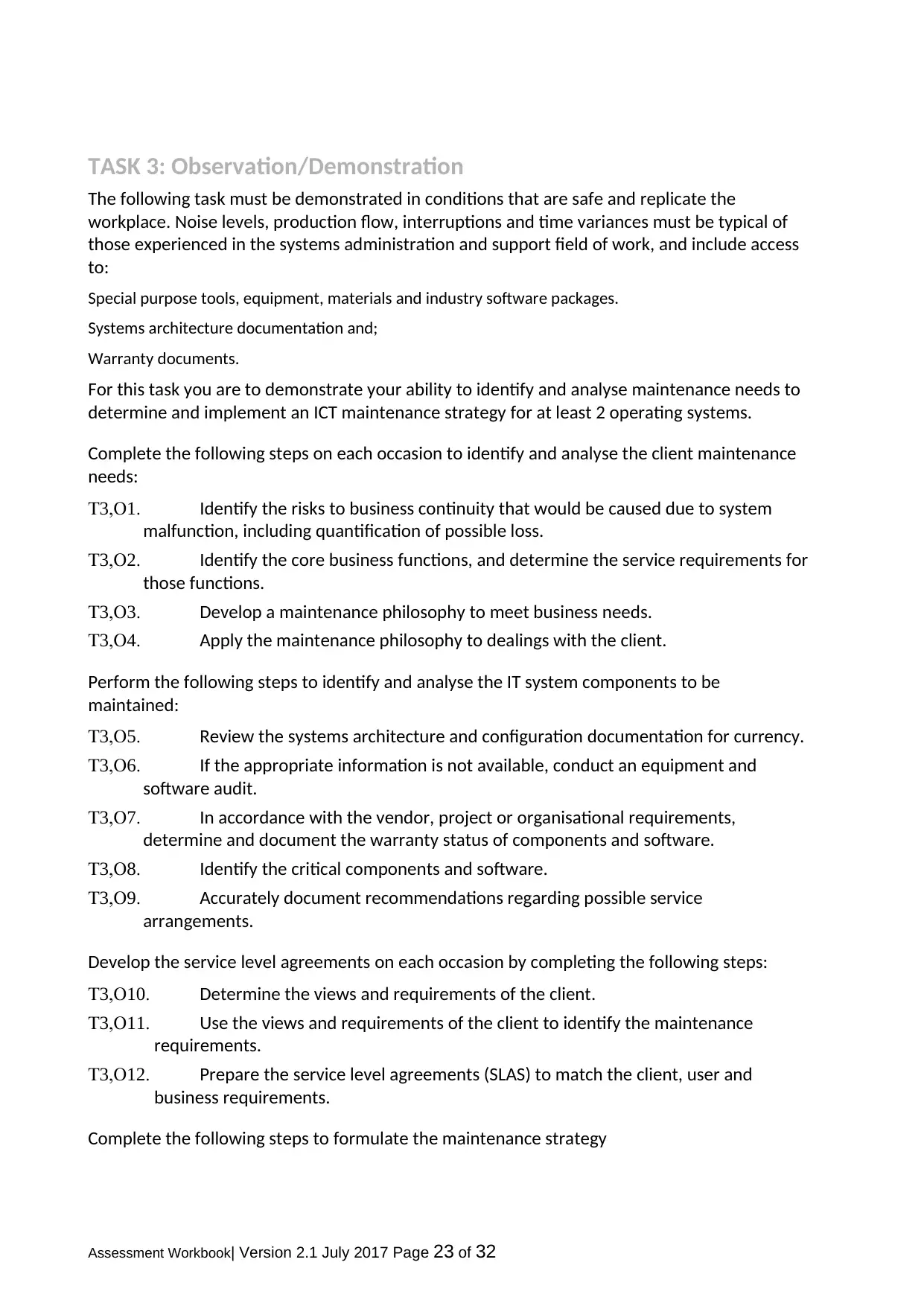
TASK 3: Observation/Demonstration
The following task must be demonstrated in conditions that are safe and replicate the
workplace. Noise levels, production flow, interruptions and time variances must be typical of
those experienced in the systems administration and support field of work, and include access
to:
Special purpose tools, equipment, materials and industry software packages.
Systems architecture documentation and;
Warranty documents.
For this task you are to demonstrate your ability to identify and analyse maintenance needs to
determine and implement an ICT maintenance strategy for at least 2 operating systems.
Complete the following steps on each occasion to identify and analyse the client maintenance
needs:
T3,O1. Identify the risks to business continuity that would be caused due to system
malfunction, including quantification of possible loss.
T3,O2. Identify the core business functions, and determine the service requirements for
those functions.
T3,O3. Develop a maintenance philosophy to meet business needs.
T3,O4. Apply the maintenance philosophy to dealings with the client.
Perform the following steps to identify and analyse the IT system components to be
maintained:
T3,O5. Review the systems architecture and configuration documentation for currency.
T3,O6. If the appropriate information is not available, conduct an equipment and
software audit.
T3,O7. In accordance with the vendor, project or organisational requirements,
determine and document the warranty status of components and software.
T3,O8. Identify the critical components and software.
T3,O9. Accurately document recommendations regarding possible service
arrangements.
Develop the service level agreements on each occasion by completing the following steps:
T3,O10. Determine the views and requirements of the client.
T3,O11. Use the views and requirements of the client to identify the maintenance
requirements.
T3,O12. Prepare the service level agreements (SLAS) to match the client, user and
business requirements.
Complete the following steps to formulate the maintenance strategy
Assessment Workbook| Version 2.1 July 2017 Page 23 of 32
The following task must be demonstrated in conditions that are safe and replicate the
workplace. Noise levels, production flow, interruptions and time variances must be typical of
those experienced in the systems administration and support field of work, and include access
to:
Special purpose tools, equipment, materials and industry software packages.
Systems architecture documentation and;
Warranty documents.
For this task you are to demonstrate your ability to identify and analyse maintenance needs to
determine and implement an ICT maintenance strategy for at least 2 operating systems.
Complete the following steps on each occasion to identify and analyse the client maintenance
needs:
T3,O1. Identify the risks to business continuity that would be caused due to system
malfunction, including quantification of possible loss.
T3,O2. Identify the core business functions, and determine the service requirements for
those functions.
T3,O3. Develop a maintenance philosophy to meet business needs.
T3,O4. Apply the maintenance philosophy to dealings with the client.
Perform the following steps to identify and analyse the IT system components to be
maintained:
T3,O5. Review the systems architecture and configuration documentation for currency.
T3,O6. If the appropriate information is not available, conduct an equipment and
software audit.
T3,O7. In accordance with the vendor, project or organisational requirements,
determine and document the warranty status of components and software.
T3,O8. Identify the critical components and software.
T3,O9. Accurately document recommendations regarding possible service
arrangements.
Develop the service level agreements on each occasion by completing the following steps:
T3,O10. Determine the views and requirements of the client.
T3,O11. Use the views and requirements of the client to identify the maintenance
requirements.
T3,O12. Prepare the service level agreements (SLAS) to match the client, user and
business requirements.
Complete the following steps to formulate the maintenance strategy
Assessment Workbook| Version 2.1 July 2017 Page 23 of 32
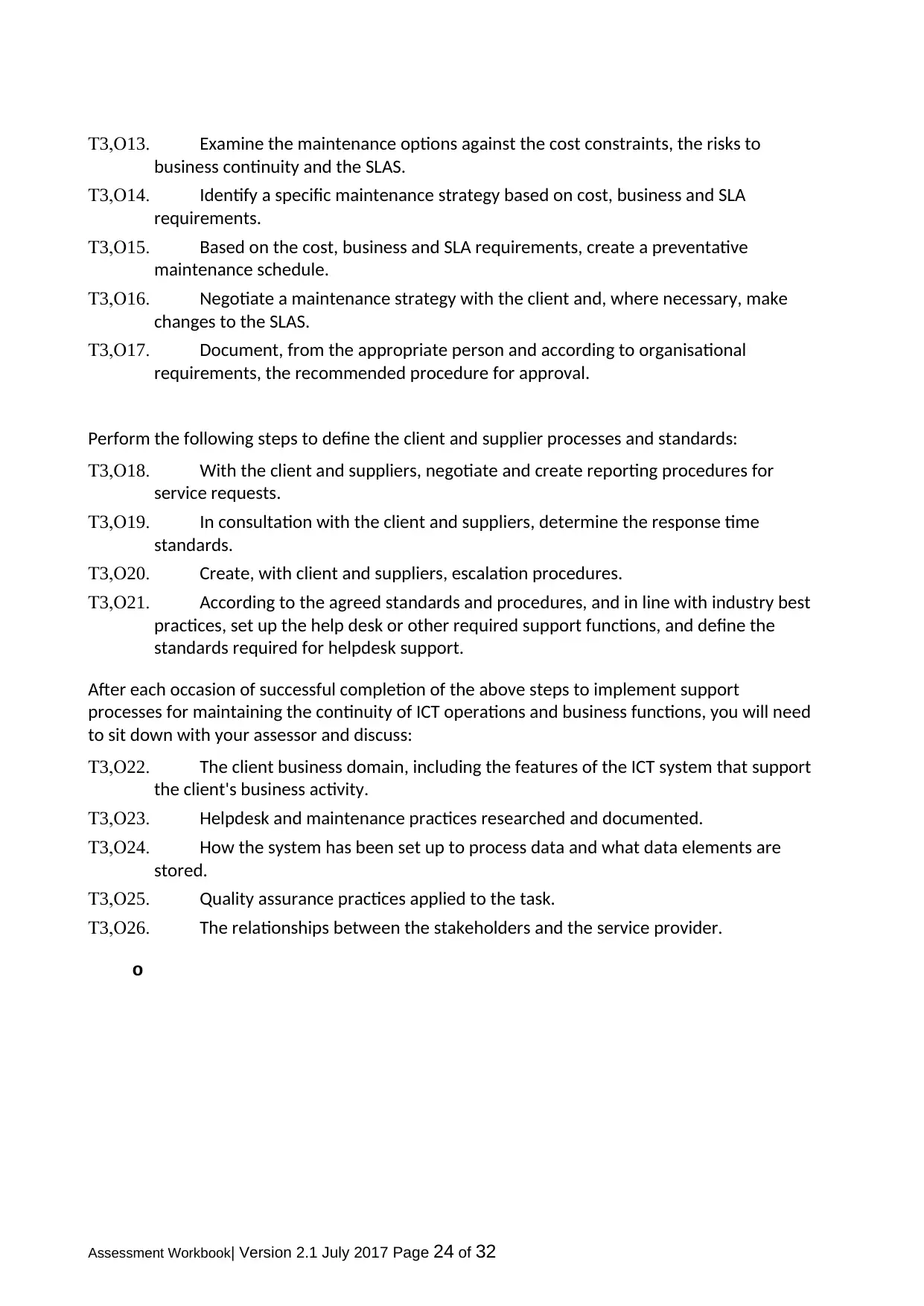
T3,O13. Examine the maintenance options against the cost constraints, the risks to
business continuity and the SLAS.
T3,O14. Identify a specific maintenance strategy based on cost, business and SLA
requirements.
T3,O15. Based on the cost, business and SLA requirements, create a preventative
maintenance schedule.
T3,O16. Negotiate a maintenance strategy with the client and, where necessary, make
changes to the SLAS.
T3,O17. Document, from the appropriate person and according to organisational
requirements, the recommended procedure for approval.
Perform the following steps to define the client and supplier processes and standards:
T3,O18. With the client and suppliers, negotiate and create reporting procedures for
service requests.
T3,O19. In consultation with the client and suppliers, determine the response time
standards.
T3,O20. Create, with client and suppliers, escalation procedures.
T3,O21. According to the agreed standards and procedures, and in line with industry best
practices, set up the help desk or other required support functions, and define the
standards required for helpdesk support.
After each occasion of successful completion of the above steps to implement support
processes for maintaining the continuity of ICT operations and business functions, you will need
to sit down with your assessor and discuss:
T3,O22. The client business domain, including the features of the ICT system that support
the client's business activity.
T3,O23. Helpdesk and maintenance practices researched and documented.
T3,O24. How the system has been set up to process data and what data elements are
stored.
T3,O25. Quality assurance practices applied to the task.
T3,O26. The relationships between the stakeholders and the service provider.
o
Assessment Workbook| Version 2.1 July 2017 Page 24 of 32
business continuity and the SLAS.
T3,O14. Identify a specific maintenance strategy based on cost, business and SLA
requirements.
T3,O15. Based on the cost, business and SLA requirements, create a preventative
maintenance schedule.
T3,O16. Negotiate a maintenance strategy with the client and, where necessary, make
changes to the SLAS.
T3,O17. Document, from the appropriate person and according to organisational
requirements, the recommended procedure for approval.
Perform the following steps to define the client and supplier processes and standards:
T3,O18. With the client and suppliers, negotiate and create reporting procedures for
service requests.
T3,O19. In consultation with the client and suppliers, determine the response time
standards.
T3,O20. Create, with client and suppliers, escalation procedures.
T3,O21. According to the agreed standards and procedures, and in line with industry best
practices, set up the help desk or other required support functions, and define the
standards required for helpdesk support.
After each occasion of successful completion of the above steps to implement support
processes for maintaining the continuity of ICT operations and business functions, you will need
to sit down with your assessor and discuss:
T3,O22. The client business domain, including the features of the ICT system that support
the client's business activity.
T3,O23. Helpdesk and maintenance practices researched and documented.
T3,O24. How the system has been set up to process data and what data elements are
stored.
T3,O25. Quality assurance practices applied to the task.
T3,O26. The relationships between the stakeholders and the service provider.
o
Assessment Workbook| Version 2.1 July 2017 Page 24 of 32
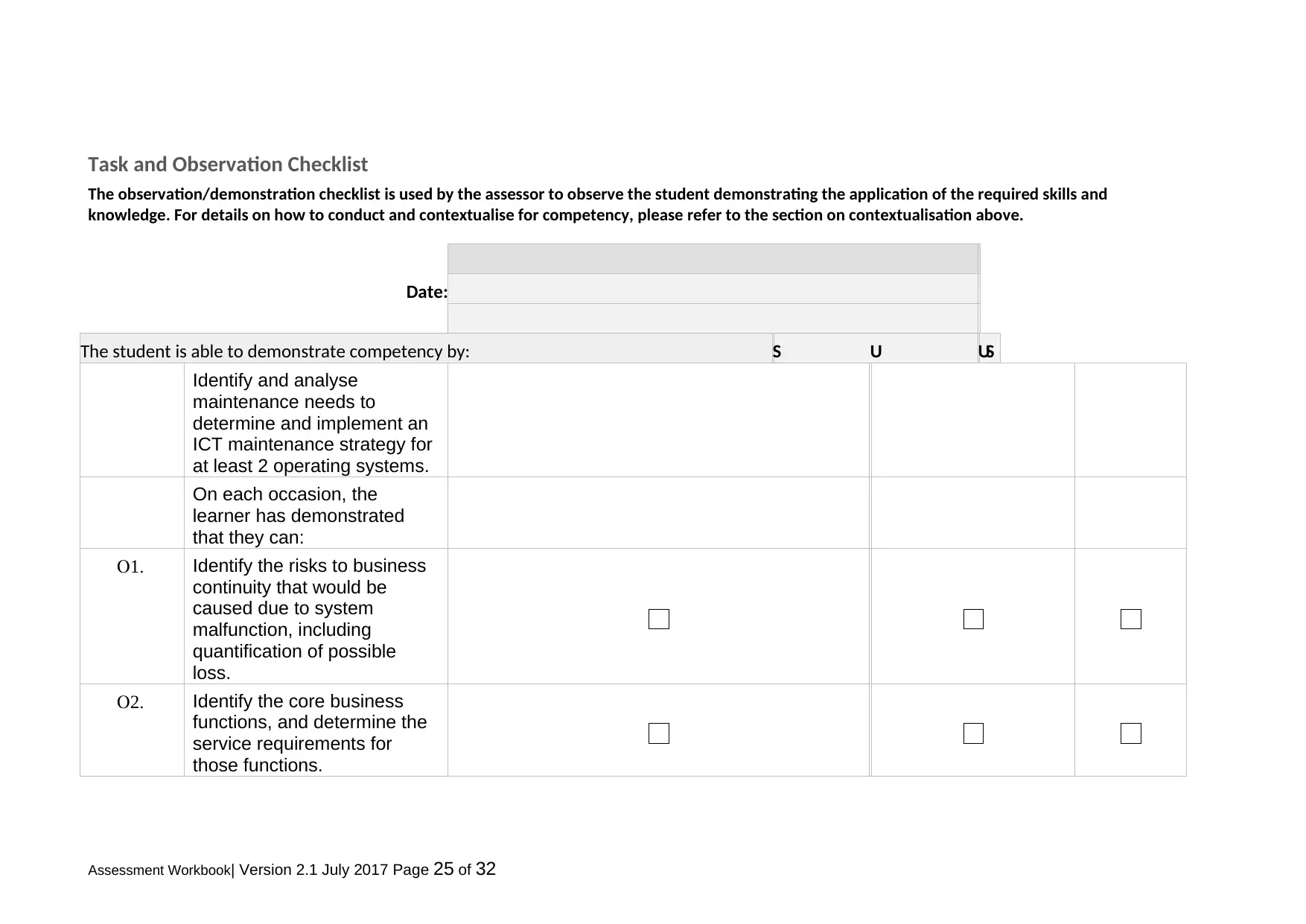
Task and Observation Checklist
The observation/demonstration checklist is used by the assessor to observe the student demonstrating the application of the required skills and
knowledge. For details on how to conduct and contextualise for competency, please refer to the section on contextualisation above.
Date:
The student is able to demonstrate competency by: S U US
Identify and analyse
maintenance needs to
determine and implement an
ICT maintenance strategy for
at least 2 operating systems.
On each occasion, the
learner has demonstrated
that they can:
O1. Identify the risks to business
continuity that would be
caused due to system
malfunction, including
quantification of possible
loss.
O2. Identify the core business
functions, and determine the
service requirements for
those functions.
Assessment Workbook| Version 2.1 July 2017 Page 25 of 32
The observation/demonstration checklist is used by the assessor to observe the student demonstrating the application of the required skills and
knowledge. For details on how to conduct and contextualise for competency, please refer to the section on contextualisation above.
Date:
The student is able to demonstrate competency by: S U US
Identify and analyse
maintenance needs to
determine and implement an
ICT maintenance strategy for
at least 2 operating systems.
On each occasion, the
learner has demonstrated
that they can:
O1. Identify the risks to business
continuity that would be
caused due to system
malfunction, including
quantification of possible
loss.
O2. Identify the core business
functions, and determine the
service requirements for
those functions.
Assessment Workbook| Version 2.1 July 2017 Page 25 of 32
Paraphrase This Document
Need a fresh take? Get an instant paraphrase of this document with our AI Paraphraser
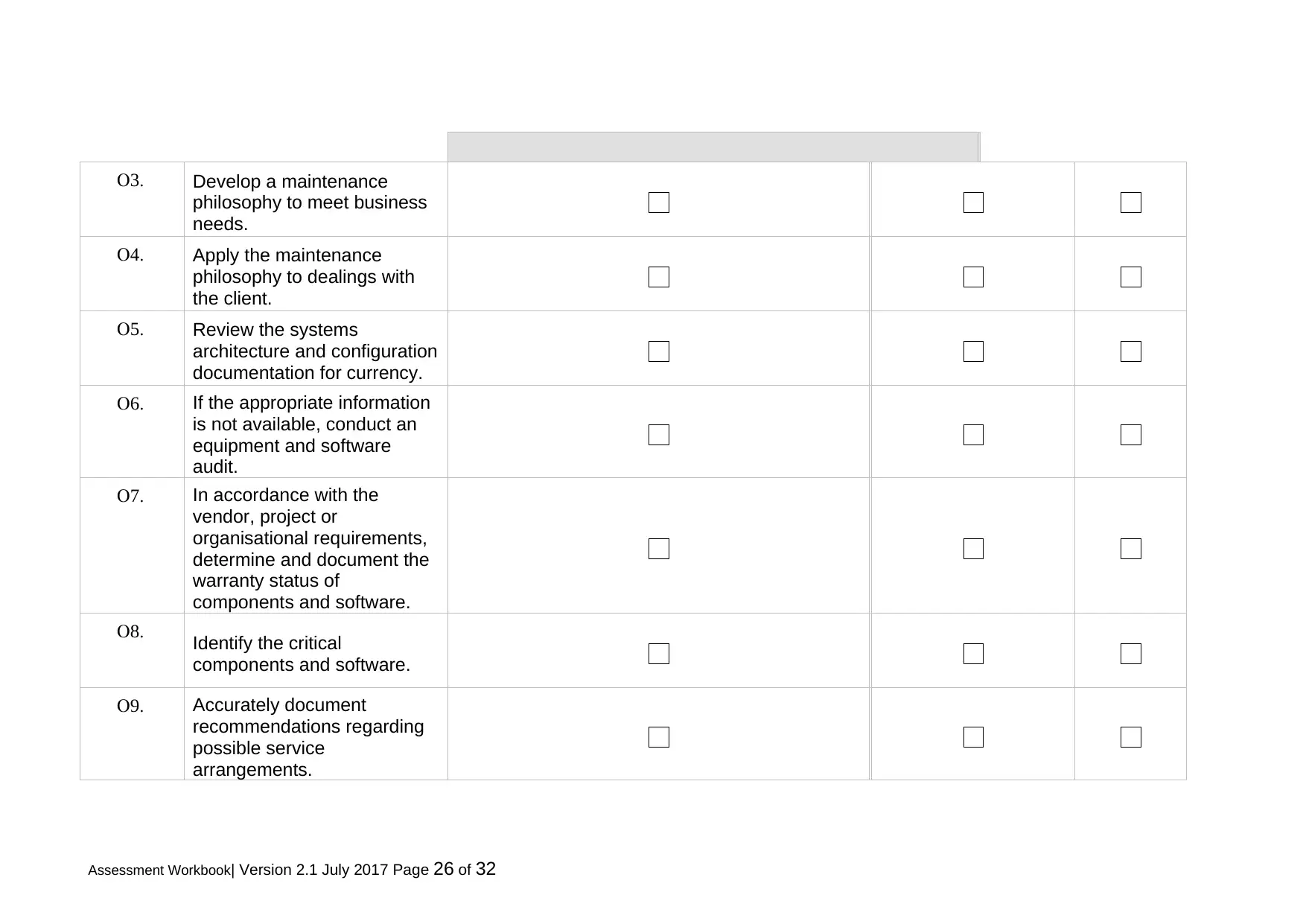
O3. Develop a maintenance
philosophy to meet business
needs.
O4. Apply the maintenance
philosophy to dealings with
the client.
O5. Review the systems
architecture and configuration
documentation for currency.
O6. If the appropriate information
is not available, conduct an
equipment and software
audit.
O7. In accordance with the
vendor, project or
organisational requirements,
determine and document the
warranty status of
components and software.
O8. Identify the critical
components and software.
O9. Accurately document
recommendations regarding
possible service
arrangements.
Assessment Workbook| Version 2.1 July 2017 Page 26 of 32
philosophy to meet business
needs.
O4. Apply the maintenance
philosophy to dealings with
the client.
O5. Review the systems
architecture and configuration
documentation for currency.
O6. If the appropriate information
is not available, conduct an
equipment and software
audit.
O7. In accordance with the
vendor, project or
organisational requirements,
determine and document the
warranty status of
components and software.
O8. Identify the critical
components and software.
O9. Accurately document
recommendations regarding
possible service
arrangements.
Assessment Workbook| Version 2.1 July 2017 Page 26 of 32
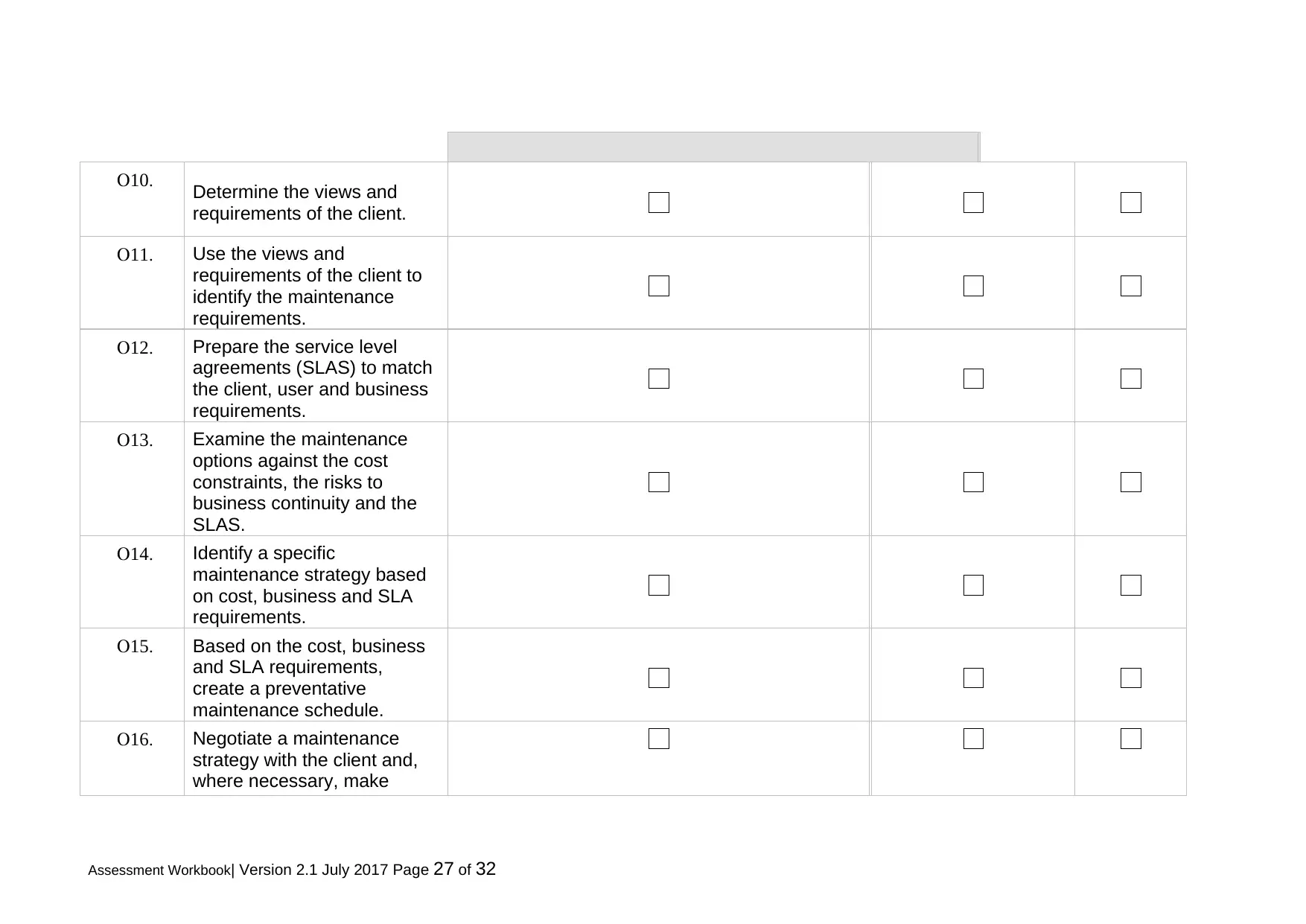
O10. Determine the views and
requirements of the client.
O11. Use the views and
requirements of the client to
identify the maintenance
requirements.
O12. Prepare the service level
agreements (SLAS) to match
the client, user and business
requirements.
O13. Examine the maintenance
options against the cost
constraints, the risks to
business continuity and the
SLAS.
O14. Identify a specific
maintenance strategy based
on cost, business and SLA
requirements.
O15. Based on the cost, business
and SLA requirements,
create a preventative
maintenance schedule.
O16. Negotiate a maintenance
strategy with the client and,
where necessary, make
Assessment Workbook| Version 2.1 July 2017 Page 27 of 32
requirements of the client.
O11. Use the views and
requirements of the client to
identify the maintenance
requirements.
O12. Prepare the service level
agreements (SLAS) to match
the client, user and business
requirements.
O13. Examine the maintenance
options against the cost
constraints, the risks to
business continuity and the
SLAS.
O14. Identify a specific
maintenance strategy based
on cost, business and SLA
requirements.
O15. Based on the cost, business
and SLA requirements,
create a preventative
maintenance schedule.
O16. Negotiate a maintenance
strategy with the client and,
where necessary, make
Assessment Workbook| Version 2.1 July 2017 Page 27 of 32
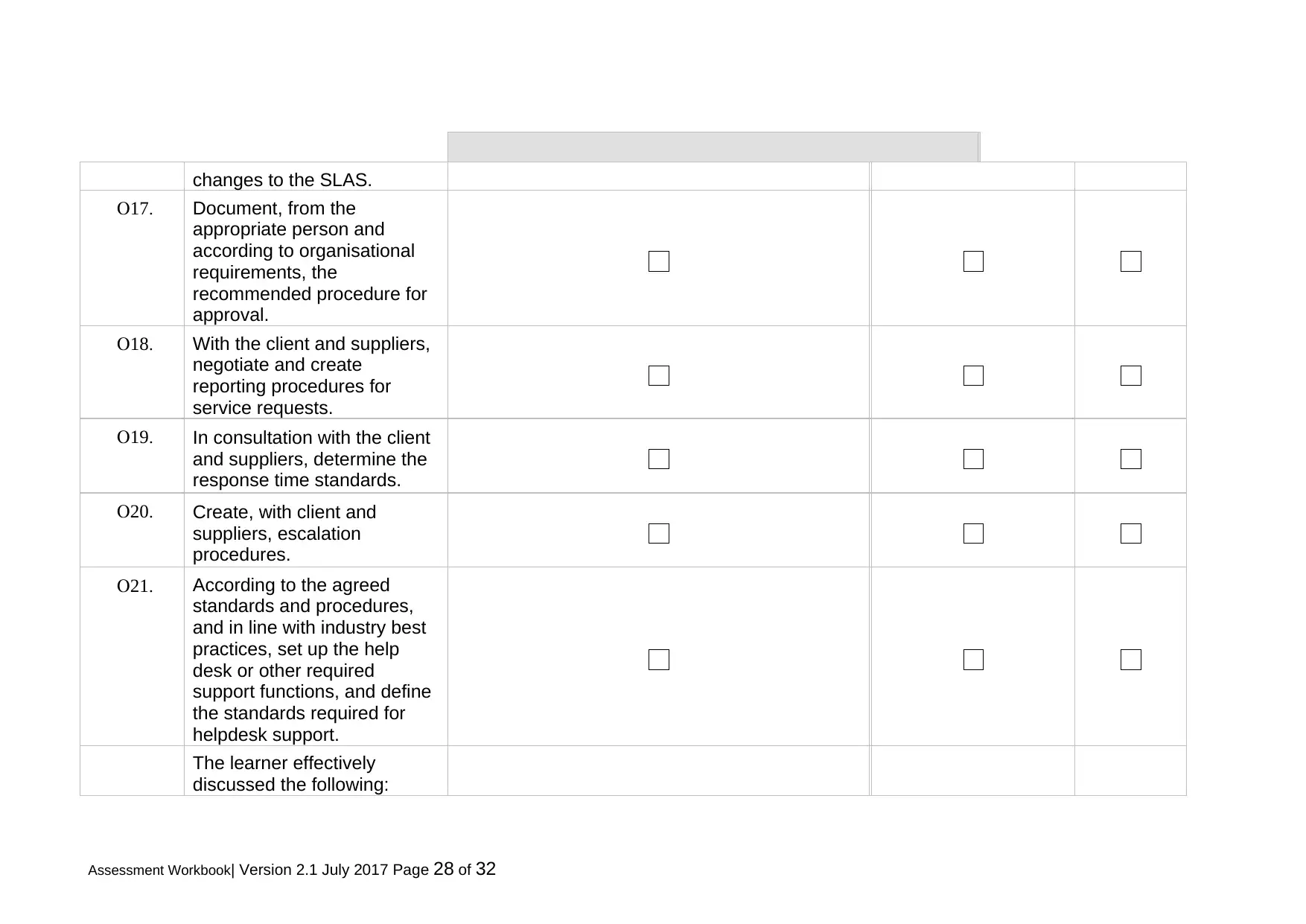
changes to the SLAS.
O17. Document, from the
appropriate person and
according to organisational
requirements, the
recommended procedure for
approval.
O18. With the client and suppliers,
negotiate and create
reporting procedures for
service requests.
O19. In consultation with the client
and suppliers, determine the
response time standards.
O20. Create, with client and
suppliers, escalation
procedures.
O21. According to the agreed
standards and procedures,
and in line with industry best
practices, set up the help
desk or other required
support functions, and define
the standards required for
helpdesk support.
The learner effectively
discussed the following:
Assessment Workbook| Version 2.1 July 2017 Page 28 of 32
O17. Document, from the
appropriate person and
according to organisational
requirements, the
recommended procedure for
approval.
O18. With the client and suppliers,
negotiate and create
reporting procedures for
service requests.
O19. In consultation with the client
and suppliers, determine the
response time standards.
O20. Create, with client and
suppliers, escalation
procedures.
O21. According to the agreed
standards and procedures,
and in line with industry best
practices, set up the help
desk or other required
support functions, and define
the standards required for
helpdesk support.
The learner effectively
discussed the following:
Assessment Workbook| Version 2.1 July 2017 Page 28 of 32
Secure Best Marks with AI Grader
Need help grading? Try our AI Grader for instant feedback on your assignments.
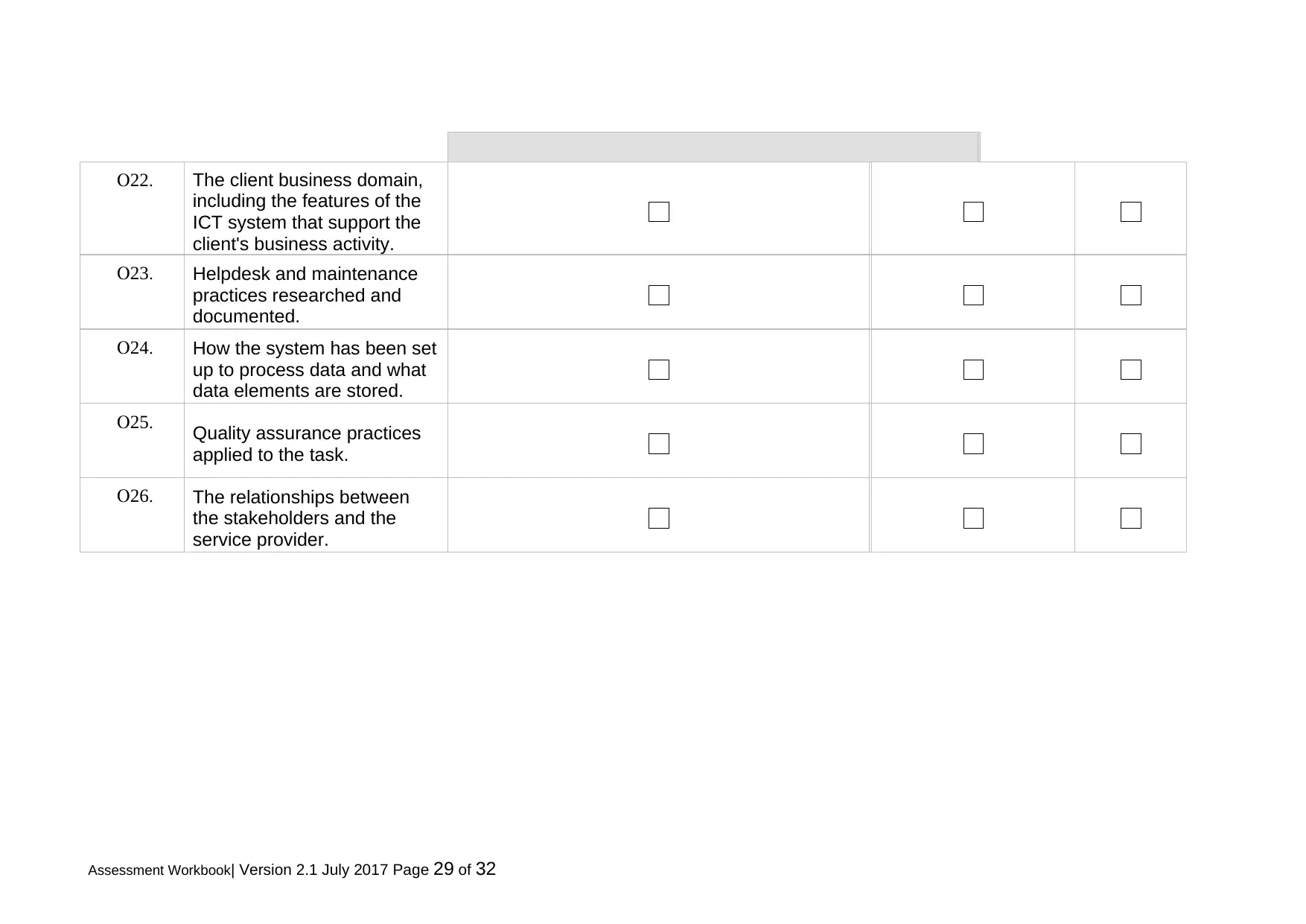
O22. The client business domain,
including the features of the
ICT system that support the
client's business activity.
O23. Helpdesk and maintenance
practices researched and
documented.
O24. How the system has been set
up to process data and what
data elements are stored.
O25. Quality assurance practices
applied to the task.
O26. The relationships between
the stakeholders and the
service provider.
Assessment Workbook| Version 2.1 July 2017 Page 29 of 32
including the features of the
ICT system that support the
client's business activity.
O23. Helpdesk and maintenance
practices researched and
documented.
O24. How the system has been set
up to process data and what
data elements are stored.
O25. Quality assurance practices
applied to the task.
O26. The relationships between
the stakeholders and the
service provider.
Assessment Workbook| Version 2.1 July 2017 Page 29 of 32
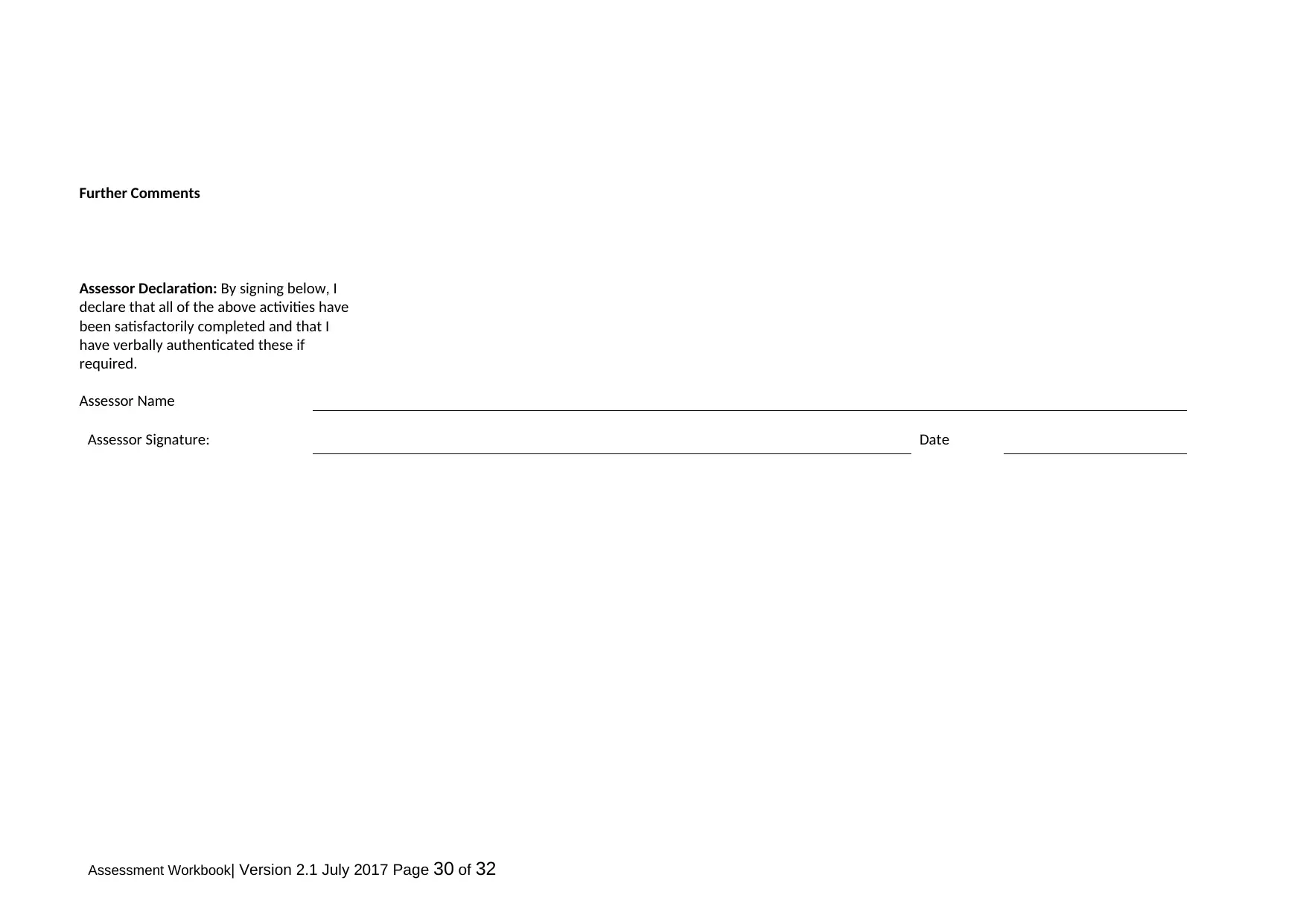
Further Comments
Assessor Declaration: By signing below, I
declare that all of the above activities have
been satisfactorily completed and that I
have verbally authenticated these if
required.
Assessor Name
Assessor Signature: Date
Assessment Workbook| Version 2.1 July 2017 Page 30 of 32
Assessor Declaration: By signing below, I
declare that all of the above activities have
been satisfactorily completed and that I
have verbally authenticated these if
required.
Assessor Name
Assessor Signature: Date
Assessment Workbook| Version 2.1 July 2017 Page 30 of 32

Assessment Workbook| Version 2.1 July 2017 Page 31 of 32
Paraphrase This Document
Need a fresh take? Get an instant paraphrase of this document with our AI Paraphraser
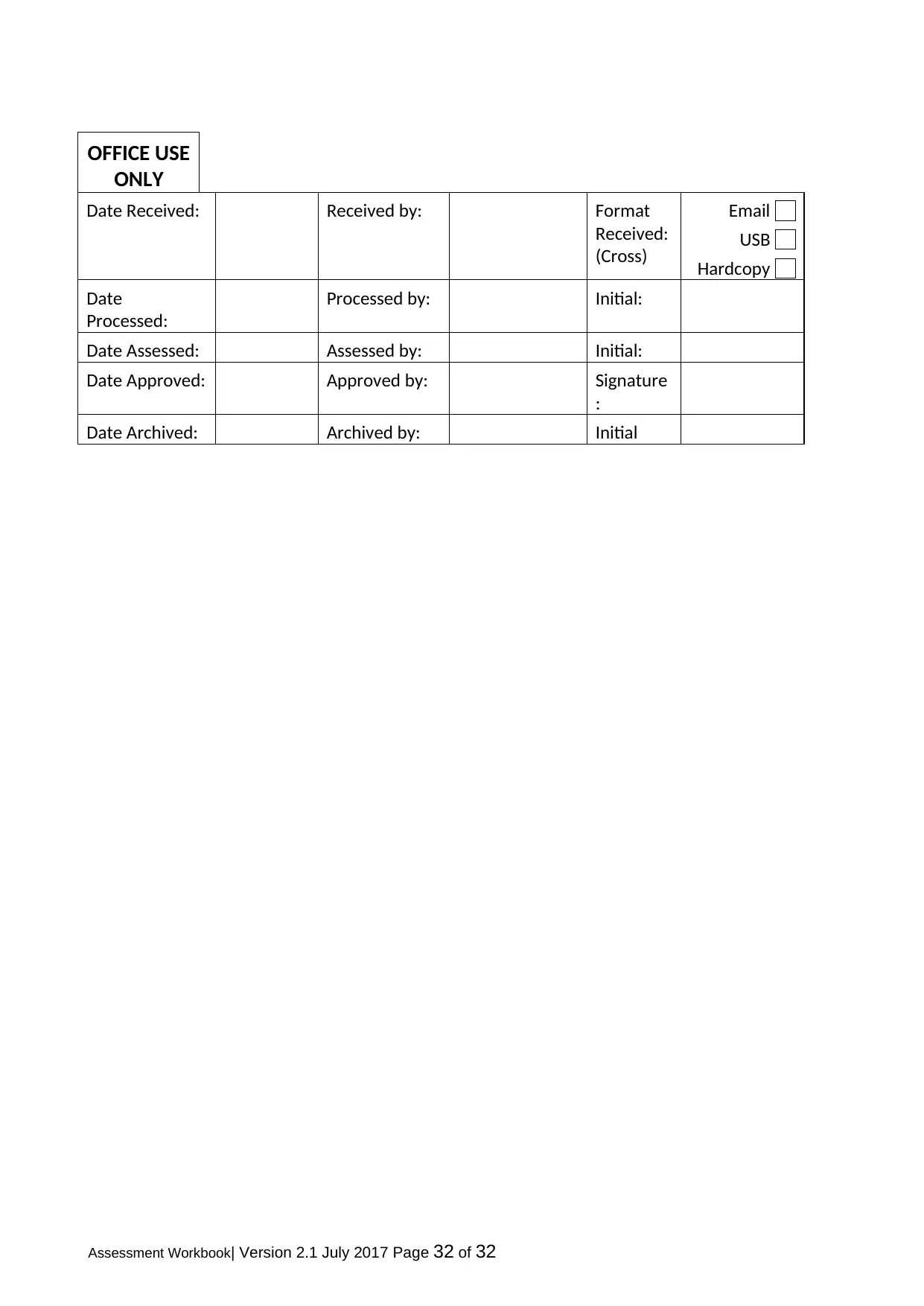
OFFICE USE
ONLY
Date Received: Received by: Format
Received:
(Cross)
Email
USB
Hardcopy
Date
Processed:
Processed by: Initial:
Date Assessed: Assessed by: Initial:
Date Approved: Approved by: Signature
:
Date Archived: Archived by: Initial
Assessment Workbook| Version 2.1 July 2017 Page 32 of 32
ONLY
Date Received: Received by: Format
Received:
(Cross)
USB
Hardcopy
Date
Processed:
Processed by: Initial:
Date Assessed: Assessed by: Initial:
Date Approved: Approved by: Signature
:
Date Archived: Archived by: Initial
Assessment Workbook| Version 2.1 July 2017 Page 32 of 32
1 out of 32
Related Documents
Your All-in-One AI-Powered Toolkit for Academic Success.
+13062052269
info@desklib.com
Available 24*7 on WhatsApp / Email
![[object Object]](/_next/static/media/star-bottom.7253800d.svg)
Unlock your academic potential
© 2024 | Zucol Services PVT LTD | All rights reserved.





